#Naval Battle of Hakodate
Text
1869-Naval Battle of Hakodate

The Naval Battle of Hakodate (函館湾海戦, Hakodatewan Kaisen) was fought from 4 to 10 May 1869, between the remnants of the Tokugawa shogunate navy, consolidated into the armed forces of the rebel Ezo Republic, and the newly formed Imperial Japanese Navy. It was one of the last stages of Battle of Hakodate during the Boshin War, and occurred near Hakodate in the northern Japanese island of Hokkaidō.
0 notes
Text
kojima visiting hakodate right now, do you think he's doing naval battle studies and the battle of miyako b-is tackled to the ground and restrained-
2 notes
·
View notes
Text
Events 5.4 (before 1950)
1256 – The Augustinian monastic order is constituted at the Lecceto Monastery when Pope Alexander IV issues a papal bull Licet ecclesiae catholicae.
1415 – Religious reformers John Wycliffe and Jan Hus are condemned as heretics at the Council of Constance.
1436 – Assassination of the Swedish rebel (later national hero) Engelbrekt Engelbrektsson
1471 – Wars of the Roses: The Battle of Tewkesbury: Edward IV defeats a Lancastrian Army and kills Edward of Westminster, Prince of Wales.
1493 – Pope Alexander VI divides the New World between Spain and Portugal along the Line of Demarcation.
1626 – Dutch explorer Peter Minuit arrives in New Netherland (present day Manhattan Island) aboard the See Meeuw.
1686 – The Municipality of Ilagan is founded in the Philippines.
1738 – The Imperial Theatrical School, now known as Vaganova Academy of Russian Ballet, was founded under the reign of Empress Anna. It is the first ballet school in Russia and second in the world.
1776 – Rhode Island becomes the first American colony to renounce allegiance to King George III.
1799 – Fourth Anglo-Mysore War: The Battle of Seringapatam: The siege of Seringapatam ends when the city is invaded and Tipu Sultan killed by the besieging British army, under the command of General George Harris.
1814 – Emperor Napoleon arrives at Portoferraio on the island of Elba to begin his exile.
1814 – King Ferdinand VII abolishes the Spanish Constitution of 1812, returning Spain to absolutism.
1836 – Formation of Ancient Order of Hibernians
1859 – The Cornwall Railway opens across the Royal Albert Bridge linking Devon and Cornwall in England.
1869 – The Naval Battle of Hakodate is fought in Japan.
1871 – The National Association, the first professional baseball league, opens its first season in Fort Wayne, Indiana.
1886 – Haymarket affair: In Chicago, United States, a homemade bomb is thrown at police officers trying to break up a labor rally, killing one officer. Ensuing gunfire leads to the deaths of a further seven officers and four civilians.
1904 – The United States begins construction of the Panama Canal.
1910 – The Royal Canadian Navy is created.
1912 – Italy occupies the Ottoman island of Rhodes.
1919 – May Fourth Movement: Student demonstrations take place in Tiananmen Square in Beijing, China, protesting the Treaty of Versailles, which transferred Chinese territory to Japan.
1926 – The United Kingdom general strike begins.
1927 – The Academy of Motion Picture Arts and Sciences is incorporated.
1932 – In Atlanta, mobster Al Capone begins serving an eleven-year prison sentence for tax evasion.
1942 – World War II: The Battle of the Coral Sea begins with an attack by aircraft from the United States aircraft carrier USS Yorktown on Japanese naval forces at Tulagi Island in the Solomon Islands. The Japanese forces had invaded Tulagi the day before.
1945 – World War II: Neuengamme concentration camp near Hamburg is liberated by the British Army.
1945 – World War II: The German surrender at Lüneburg Heath is signed, coming into effect the following day. It encompasses all Wehrmacht units in the Netherlands, Denmark and northwest Germany.
1946 – In San Francisco Bay, U.S. Marines from the nearby Treasure Island Naval Base stop a two-day riot at Alcatraz Federal Penitentiary. Five people are killed in the riot.
1949 – The entire Torino football team (except for two players who did not take the trip: Sauro Tomà, due to an injury and Renato Gandolfi, because of coach request) is killed in a plane crash.
0 notes
Text
GK Fanbook official timeline
In June I translated the official timeline that was on the GK main site... and that Tumblr somehow hates as it refuses to appear in the tags.
I’m glad to update the info that were in that timeline with the new timeline Noda made for the fanbook, which is definitely a must have so I recommend everyone to buy it!
I might add to it pictures later on. I’m sad to say though it’s not yet a complete timeline as some facts are missing but whatever, it’s a lot more informative than the previous and this will give me the chance to release a more complete one as soon as I’ll have time to add all the datas that are missing.
In the meantime, please enjoy it!
(Also, if you catch mistakes please warn me...)
GOLDEN KAMUY BACKGROUND
Augmented revised edition.
This is a chronological table reconstructed by adding to "Golden Kamuy BACKGROUND" released on the official website the events and historical facts found so far.
1835 May (31): Hijikata Toshizō is born in the Musashi Province.
1839 May (23): Nagakura Shinpachi is born in the Musashi Province.
1853 July: Perry Expedition.
1854 March: The Convention of Kanagawa is concluded.
1858 July: The Treaty of Amity and Commerce is signed.
1858 September: Ansei purge.
1859 March (circa): Hijikata Toshizō is officially enrolled at the Tennen Rishin-ryū’s Shieikan dōjō.
1860 March: Sakuradamon Incident.
1862 September: Namamugi incident.
1863 (circa): Nagakura Shinpachi becomes a guest at the Shieikan dōjō.
1863 March: The Rōshigumi is organized. Hijikata Toshizō and Nagakura Shinpachi are assigned to the third corp.
1863 April: The Rōshigumi splits. Serizawa Kamo, Kondō Isami and others organize the Mibu Rōshigumi. Hijikata Toshizō and Nagakura Shinpachi join the Kondō faction.
1863 May: The bombardment by the Chōshū Domain of a foreign ship affair.
1863 August: Anglo-Satsuma War.
1863 August (circa): Political change on August 18. The Rōshigumi is honored for its achievements in this period and renamed “Shinsengumi”.
1863 September (circa): Hijikata Toshizō becomes the Vice-Commander of the Shinsengumi. As the right arm of Kondō Isami, who became the director, he maintains security in Kyoto.
- Yōichirō the manslayer and Hijikata Toshizō met in Kyōto.
1864 July: The Ikedaya incident occurs. Kondō Isami, Nagakura Shinpachi and others attacks the men of Chōshū and Tosa Domains of the Sonno Jōi faction. Hijikata Toshizō secured the entrance and exit around Ikedaya and protected the credit of the Shinsengumi.
1864 August: Kinmon incident (Crimson gate incident).
1864 August: The bombardment by a fleet of 4 nations at Shimonoseki affair.
1864 December: First Chōshū expedition.
1866 March: Satchō Alliance.
1866 July: Second Chōshū expedition.
1866: Western-style horse racing is held in Negishi.
1866: Kiroranke is born in the Amur river basin.
1867 November: Restoration of imperial rule.
1868 January: Great Order of the Restoration of the Royal Government.
1868 January: The Boshin War begins starting with the battle between Toba and Fushimi.
1868 March: Nagakura Shinpachi meets Kondō Isami, who had been defeated in the Battle of Kōshū-Katsunuma, and splits with the Shinsengumi.
1868 April: The Charter Oath.
1868 May: Bloodless opening of Edo Castle. Kondō Isami, who was captured by the new government army, is executed
- Clog skating, commonly known as "gerori", spreads explosively in Ezo in the latter half of the Edo period.
1868 June: Battle of Aizu.
1868 October: Edo is called Tōkyō, the Meiji era starts.
1868 December: The Battle of Hakodate (Boshin War - Battle of Goryokaku). Hijikata Toshizō fights with Murahashi Hisanari, the commander of the new government army. In this war, Inudō Shirosuke's older brother served in the new government army. He died in battle.
1869 May: Battle of Miyako Bay. Hijikata Toshizō, on the warship Kaiten, launches a naval boarding attack (French: Abordage) on the new government warship, Kotetsu.
1869 May: Hijikata Toshizō is captured by the new government army and is treated as a prisoner of war.
1869 May: Takeaki Enomoto, President of the Republic of Ezo, surrenders. As a result, the Battle of Hakodate ends with the victory of the new government army, and the Boshin War ends.
1869 July: Returning the land to the emperor implementation.
1869 August: “Ezo” is renamed “Hokkaidō”. Around this time, "Hakodate" began to change to "Hakodate" notation.
1871 August: Implementation of the abolition of the han system.
1872: The “Solar Calendar”, or Gregorian Calendar is adopted the day following December 2, Meiji 5, which becomes January 1, Meiji 6 (regulated as January 1, 1873 in the Gregorian calendar).
1873 January: Military conscription issued by the Ministry of Army.
1873 February: The ban on Christian faith was lifted.
1873: Birth of Heinojō, Koito Otonoshin’s older brother.
1874: Military settler colonists system is established. It is implemented from the following year.
1875 August: The Treaty of Saint Petersburg with the Russian empire is concluded. It’s established that South Sakhalin is the new borderline with the Japanese territory.
1876 March: Promulgation of the Sword Abolishment Edict.
Murawashi Hisanari, a pioneer government official, is involved in the establishment of a brewery (later Sapporo Breweries).
1877 February: Satsuma Rebellion.
1877 (circa): Roller skates are introduced to Japan.
1879 From February to March 1879: Abnormal weather occurred in winter leading to mass death of Ezo deer due to heavy snow, storms and cold.
- Hokkaido wolves are in danger of extinction due to low deer prey.
1881 March: Emperor Alexander II is assassinated by Kiroranke and Wilk.
1881 September: Kabato prisoner’s accommodation facility (later Kabato Prison) opened. Hijikata is also imprisoned in this prison.
1882: Nagakura Shinpachi becomes a swordsman instructor at Kabato prison and starts instructing guards.
1882: Military settler colonists uses cannons to converge locust plague.
1886 January: The Hokkaidō Government Office is established.
1886: Nagakura Shinpachi retires from his role of kenjutsu teacher in Kabato prison.
1886: Koito Otonoshi’s birth.
1888: Sakamoto Keiichirō, the lightning bandit, is imprisoned by Kabato prison.
1888 May: Forming of the First Division of the Imperial Japanese Army.
1889: Is this the last confirmed sighting of an Ezo wolf?
1889 February: The Imperial Japanese Constitution is proclaimed.
1890 March: Abashiri public prison office (later Abashiri Prison) opened.
1890 November: The Imperial Japanese Constitution is in force.
1890 (circa): Most of the Hokkaido wolves are said to have been exterminated and allegedly extinct.
1891: An albino bear cub is captured in the Soya region and raised by the Ueno Zoo.
1891 (and after): Wilk, Kiroranke and Sofia go to Hasegawa Photo Studio to learn Japanese.
- Wilk and Kiroranke walk on the ice field to Sakhalin, Sophia remains in Russia. After this, Wilk travels to Hokkaido and meets Inkamat.
1892: Opening of mining in the Yubari Coal Mine.
1892: Hijikata’s favorite gun, the “Winchester model M1892”, is designed and manufactured.
1893: Tsurumi’s favorite gun, the “Borchardt pistol”, is designed and manufactured.
1893 (circa): Shiraishi Yoshitake makes a plan to escape from the child prison.
1894 (circa): Tsukishima Hajime joins the 2nd Division in Shibata, Niigata Prefecture.
1894 July: Sino-Japanese war.
1894 September: The flagship Matsushima was wrecked in the Battle of the Yalu River on the 17th. At this time, Koito Heinojō, who was on board the ship, was killed in action.
- The only son of Nihei Tetsuzō died in the Sino-Japanese War.
1895 March: End of the Sino-Japanese war.
- Around the end of the Sino-Japanese War, “Igogusa”-chan’s letters to Tsukishima interrupt.
1895 April: Signing of the treaty of Shimonoseki (Sino-Japanese Treaty).
1895 (and after): Sakamoto Keiichirō escapes from Kabato prison during outside labor. After this, he has a fateful encounter with O-gin.
- Nihei Tetsuzō go hunting with Kirawus. It’s in this circumstance, he is told why Nihei favors the Murata rifle.
1896 May: Forming of the 7th Division of the Imperial Japanese Army with military settler colonists.
1896: The last Ezo Wolf fur export trade was done by the Hakodate fur trader, Matsushita Kumatsuki.
1896: The Sulfur mining by Abashiri Prison prisoners is stopped.
1896: The mine on Mt. Io between Lake Mashu and Lake Kussharo is closes.
1896: Tsurumi meets Tsukishima Hajime in prison.
1897: Record for that annual herring catch which is of 975,000 tons.
1897 (and after): Shiraishi Yoshitake, after being imprisoned at Kabato Prison goes around prisons all over the country and gained the nickname of "Jailbreak King".
1898: Gold is discovered in the Esashi basin. The dawn of the Hokkaido version of the gold rush.
1899: Sugimoto Saichi’s father died of tuberculosis and he leaves his home.
1900: Koito Otonoshin and Tsurumi Tokushirō meet.
- Hijikata Toshizō, who has been imprisoned by Kabato Prison for about 20 years, reunites with Nagakura Shinpachi. After that, Hijikata is transferred to Abashiri Prison.
1902 January: Anglo-Japanese Alliance.
1902: Seven Ainu who were transferring gold are killed by someone in Tomakomai. Among the victims there was Ariko Rikimatsu’s father.
- A fleeing Wilk is arrested at Lake Shikotsu. When imprisoned in Abashiri Prison, he carved the gold code into the prisoners on the death penalty row.
1902: Koito Otonoshin is kidnapped by suspected Russian criminals. The case reaches a positive resolution thanks to Tsurumi's cooperation. After this, Koito Otonoshin entered the Army Military Academy.
(Late developments of the manga seem to imply this happened prior to the seven Ainu being killed.)
1903 January: Hakkōda Mountains incident. Ariko Rikimatsu joins the search team for distress cases.
(In real life the incident actually took place on 1902 January. Late developments of the manga seem to imply this is true also in the manga.)
1903: Sugimoto Saichi joins the 1st Division of the Imperial Japanese Army.
1903 (circa): Some military settler colonists transfer the tattooed prisoners. At this time, Hijikata Toshizō and others killed the military settler colonists and escaped. Twenty-four tattooed prisoners are unleashed.
(Late developments of the manga claim that the convicts escaped were only 23.)
1904 February 8: Russo-Japanese war.
1904 August: Siege of Port Arthur. The 1st Division to which Sugimoto belongs and the 7th Division to which Tsurumi, Ogata, Tanigaki, Kiroranke and others belong are thrown into battle. Hokkaido 7th Division, Shikoku 11th Division, Kanazawa 9th Division, and Tōkyō 1st Division were the ones that fought at 203 hill.
- Lieutenant Tsurumi sees for the first time in the battle Immortal Sugimoto and is fascinated by him.
- Tanigaki Genjirō meets Sugimoto Saichi, a survivor of the White Sash Brigade.
- Genjiro Tanigaki learns the truth about what happened to his sister and best friend.
- Ogata Hyakunosuke shoots and kills his half brother second lieutenant Hanazawa Yūsaku.
- Lieutenant Tsurumi, gaining total control of it, raised the national flag on the summit of the 203 hill.
- Lieutenant Tsurumi and Sergeant Tsukishima were injured by a shell. Part of Tsurumi’s head is blown away.
- While being transported the injured Lieutenant Tsurumi and Sergeant Tsukishima Passing by Saichi Sugimoto, who carries his childhood friend Toraji
- Saichi Sugimoto takes care of Toraji.
1905 September: The end of the Russo-Japanese War. The Treaty of Portsmouth (Japan-Russia Peace Treaty) with the Russian Empire is concluded.
1905: Noboribetsu is designated as a recreation area for the Russo-Japanese War victims of the 7th division.
- Hijikata Toshizō asks Kiroranke about “Kochōbe Asuko”.
1906: Sugimoto Saichi delivers the remains of Toraji to Umeko.
- Ogata Hyakunosuke kills his father, Lieutenant General Hanazawa. This is passed for a suicide.
1906 September: The first issue of "Shojo Sekai", a magazine that Sugimoto was also reading, will be published.
1906 November: South Manchuria Railway Co., Ltd., a special company of the Empire of Japan, is established.
- Saichi Sugimoto goes to Otaru, Hokkaido in search of gold dust.
1907 February: An immortal man and an Ainu girl meet. The battle for the gold begins.
#Golden Kamuy#Sugimoto Saichi#Ogata Hyakunosuke#Tsurumi Tokushirou#Tsukishima Hajime#Hijikata Toshizou#Nagakura Shinpachi#Sakamoto Keiichirou#O Gin#Shiraishi Yoshitake#Tanigaki Genjirou#Golden Kamuy Timeline#Hanazawa Yuusaku#Hanazawa Koujirou#Asirpa#Wilk#Kiroranke#Sofia
132 notes
·
View notes
Text
Satsuma Dads Timeline
You know how Golden Kamuy is an awesome manga full of amazing (and super-hot) characters and a great main storyline? So what do I do with it? Naturally I obsess over those two old gremlins: Koito Heiji and Hanazawa Koujirou the fathers of Second Lieutenant Koito and Ogata.
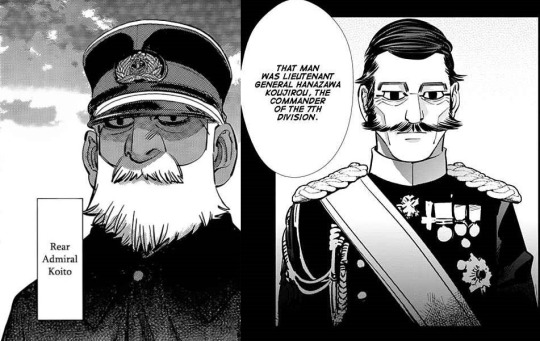
It's probably the most niche pairing ever, and I thought it was just me fixating on that one panel where Tsurumi mentioned they were close friends from Satsuma. But the more I read about the history of Satsuma and the times they lived in, the more I’m becoming convinced that there’s so much of their story written between the lines and that their relationship and tumultuous past is what actually caused and keeps together most of the GK plot. But nobody else seems to see it!

So what do I do with that? I spent my nights in front of my crazywall of historical research, trying to recreate an entire universe of events 50-years before the gold plot starts, just to be able to present to you:
The Satsuma Dads Timeline
or
Why you Should Care for Heiji and Koujirou
~1850

Koujirou and Heiji* were born around 1850** in Kagoshima.
Heiji might have been older then Koujirou, but not more then 5 years. They were both sons of high ranking samurai (noble bloodline), serving the Shimazu clan.
* Most likely they went by other names in their youth and then changed them a bazillion times to make stuff confusing, but let's skip that.
** That would make them around the same age as Tougou Heihachiro and Nogi Maresuke ** - the chief players in the Russo-Japanese war for the navy and army. Both share a lot of biographical motives with Koujirou and Heiji and Noda might have modeled them a bit after them so I'll include the parallels where possible. I'm not sure Nogi even exists in the GK universe or was he replaced by Koujirou completely. Tougou was recently confirmed to exist. He was also a Kagoshima-boy, and grew up in the same circles so it's impossible that he and Heiji didn't know each other from childhood.
1856-65
Koujirou and Heiji train in the same gochu in Kajiya-cho*. Gochu was a Satsuma-specific education system, relying on small neighborhood study groups in which the older samurai spent a part of their time teaching the younger everything they knew. Starting from penmanship and Confucian doctrines and ending with swordsmanship, and the unstoppable Jigen-ryu.
Teenage Heiji develops a Koito-crush*. on Saigo Takamori (20 years his senior) and follows him around like a lost puppy. Koujirou makes fun of him, but in reality he feels a bit jealous.
* Kajya-cho was a Kagoshima district known now as "Home town of Revitalization" as most of the influential Satsuma leaders of the Meiji Revolution came from there. That also meant that they directly taught the younger generations as part of the gochu. For example Tougou also came from that area. I'm not that sure Heiji and Koujirou were actually from Kajiya-cho, but it being 3km downhill from the Nanshu Cemetary would fit in nicely to the place where Tsurumi and Otonoshin first met so it's likely.
** Gochu was a completely male oriented environment, so homoerotic relations bloomed and were even encouraged (think ancient Greece), hence the term "Satsuma habit" was later used as the synonym of homosexuality in Japan. But for them then it was just a natural thing they sometimes did, and not really an orientation. Koito Otonoshin crushing on Tsurumi might be a bit old fashioned but it's just a Satsuma thing, so of course his dad is cool with that.
1866-67
Both go to Kyoto to serve Hisamitsu Shimazu and there they experience the tension of the Bakumatsu period first hand. They soak up the patriotic moods of the Sonno-Joi fraction, they hear of the the assassinations by the Shinsengumi, they feel a revolution brewing. Being a hot-headed youth in those times made keeping out of trouble very difficult.
1868-69

The Boshin War breaks out. Satsuma, Choshu and Tosa fight to abolish the Tokugawa shogunate. Heiji and Koujirou join up and dispite their young age are given officer commissions*. Coming from a long line of Satsuma’s military commanders it is what they were raised up to do. This war however is nothing like the stories they grew up on. Instead of swords it relies more on modern weapons guns and artillery. What was supposed to be a short battle with the Shogun's forces, turns into a lengthy nationwide campaign of crashing shogunate loyalists long after the Shogun himself resigned. Koujiro and Heiji fight side by side and survive all the way to see the end of it in Hakodate.

* Only the oficers wore the super cool Satsuma black koguma wigs and I definitely do need fanart of that.
1870
Heiji and Koujiro come out of the war victorious. Most of the positions in the new government are taken by Satsuma and Choshu men, so practically any career path is open to them. Koujiro stays with the Imperial Guard while Heiji joins the Imperial Naval Academy in Tsukiji, Tokyo. They compete for the most ridiculous facial hair* and spend their off nights “drinking green liqueurs under red lanterns”
Ogata's grandfather fought** on the other side for the Mito clan (the last shogun was from the Mito-Tokugawa branch). After the defeat his family falls into poverty. They sell their daughter to an okiya because they cannot support her ***.
* The Haitourei edict from 1871 allowed samurai to cut of their chonmage and encouraged them to experiment with western haircuts.
** I’m guessing he was active in the Boshin by the fact that he had an old gun lying around.
*** This "Ogata's mom comes from a fallen samurai family" theory has been going around but I'm not super sure about the time frame here. Usually maiko get promoted to geisha when they're 20-21. That means to already be a geisha when she gave birth to Hyakunosuke she must have been at least 12 when she was sold. That's quite late for a geisha to start her education. Or I might be wrong about Hyakunosuke's birth date, but I'd really like it to be 1879, so I'm in a pickle here.
1873
Heiji finally finds the guts to propose to Yuki, his Kagoshima sweetheart. They marry and a son is born to them - Heinojou *.
Koujirou's family chooses a wife for him **. She's from a good family, likely Choshu to have some useful connections. Heiji comes to their wedding in his fancy navy uniform to congratulate them and say goodbye. He'll be going to study abroad in the France ***. Koujirou feels like it's his funeral wake.
* Heinojou's birthdate is the first solid date we have for them from the canon, so I'm basing the whole “born in the 1850s” on the fact that the expected age of a man to marry was their early 20s.
** Arranged marriage was the most commonplace in Japan then. The families picked the brides because they were most likely to spend more time with her then the husband, taking care of the house and such.
*** In 1871 Tougou went to study abroad with 14 other cadets to Greenwich Naval Collage and that would fit so nicely. The problem is that they went 1871-1878 and Heinojou was born in 1873 *shakes fist*. There were also individual exchange programs though and since in canon Heiji is mentioned to have some french friends I figured he was sent to France.
~1876
Koujirou is stationed in Tokyo, while his wife stays in Kagoshima, taking care of the family home. He begins an affair* with Tome**, a geisha from Asaskusa. With Heiji gone she's the only person he can open his heart to.

After abolisment of the clan system and privileges of the samurai, the dissatisfied Satsuma samurai quit the Imperial Guard en-masse and go back to Kagoshima to gather around Saigo Takamori and brew a rebelion. Koujiro - by then a major - is faced with a choice: to go back with his childhood friends, or to stay loyal to the government. He chooses his career.

* I'm guessing he must have been married already when the thing started, because marrying a geisha wasn't that unheard of and wouldn't really cause a scandal or hinder his career. All three of the Meiji prime ministers Hirobumi Ito, Taro Katsura and Yamagata Aritomo ended up marrying geisha. So Tome being a geisha was not a problem - Koujiro already having a wife was.
** Tome is a random name that Ogata used in his Sugimoto self insert fic. I love the headcanon that it's his mom's name. Because of course he makes everything personal.
1877
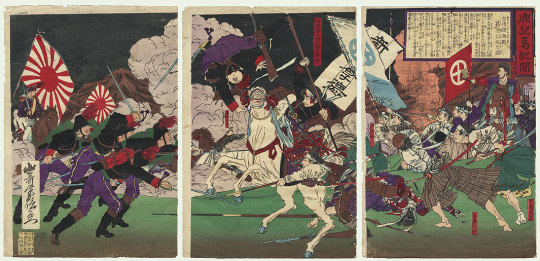
In January the Seinan War breaks out. Koujirou fights against his clansmen and his former war comrades *. By September most of them are dead. He is there at Shiroyama where Saigo makes his last stand. Heiji is never going to forgive him that.
When he comes back to Tokyo, Tome doesn't ask, she understands and prepares him angler nabe while he sulks.
* Koujirou's situation is by no means an unusual one. Many of the Satsuma samurai landed lucrative jobs under the new administration and didn't share the dissatisfaction of their disenfranchised clansmen. Even Saigo's own younger brother Judo stayed as a lieutenant-general in the Imperial Guard.
1878
In May, Okubou Toshimichi, the lord of home affairs, who took personal command of surpressing Saigo's rebelion is assasinated, branded in Satsuma as traitor.
Koujiro is not welcome in Kagoshima anymore*. His wife moves to Tokyo to avoid harassment. Keeping his affair with Tome is becoming more difficult. Especially when he learns that Tome is pregnant **
In December Heiji comes back to pick up the pieces.
* Both Okubo and Saigo Judo moved their families to Tokyo because of this situation, so I'm guessing that was a thing. They received some backlash from their compatriots but eventually things normalized (for Judo at least, because Okubo was, you know, slashed up dead in an alley). By 1898 Saigo was acknowledged by the government as a tragic hero and bygones were bygones. Yet Heiji still talks with the Satsuma dialect, while Koujiro doesn’t even have a trace of it left.I wonder if he still used it when talking to Heiji.
** Geisha were not supposed to have sex with their patrons. The fact that she chose to give birth to Koujirou's son tells that she dared to hope that he'll at least acknowledge him.
1879
In January Hyakunosuke is born*
* Ogata's birthdate is a shot in the dark. He could be anywhere between 1878 and 1883. I just really like the idea that he was born right into the middle of such a chaos.
EDIT: GoldenKamuyHunting pointed out that Ogata had to be born after 1881, since Noda placed him as Older than Usami. This ruins the timeline a bit, and I’ll have to think of the way to reorder it to fit. For now, treat the 1879 as canon-defying :(
~1881

After pressure from his parents and from Heiji, Koujirou comes clean and learns to make his official family work. Koujirou's legitimate son, Yuusaku is born*.
From now on he effectively ghosts Tome. Her mental health** begins to waver. Tome quits being a geisha and moves back to her parents in Ibaraki ***.

* Also a shot in the dark. This would make him 23 when he died and 2 years younger than Ogata.
** Before the 20th century the white makeup geisha wore was made out of lead, making them more likely to develop lead poisoning, the first symptom of which is the decline of intelectual ability. Fun fact: lead gets passed down in breastmilk in quantities super-harmful for the baby, so if we go with the theory "Tome went crazy because of lead poisoning" than that would explain so much about Ogata...
*** This is likely due to her health, not due to giving birth. She could have just sent Hyakunosuke to her parents and kept working. God knows how they made ends meet after that. Before they were be so poor that they had to sell their daughter. Now they were much older, she was sick and unable to work, and her child was another mouth to feed. Not to mention the cost geisha education was worse then US collage loans so she most likely had a large debt she barely started to repay. Was Koujiro at least decent enough to pay child-support? Oh god *realises* it was Heiji who was paying them, wasn’t it? *heart breaks*
1886
Heiji and Yuki's second son, Otonoshin is born, 13 years after the first. What's up with that, Heiji?
1887
Koujirou goes to Germany* to study military tactics.
Hyakunosuke (8) feeds his mother rat poison. Koujirou doesn't come to the funeral.
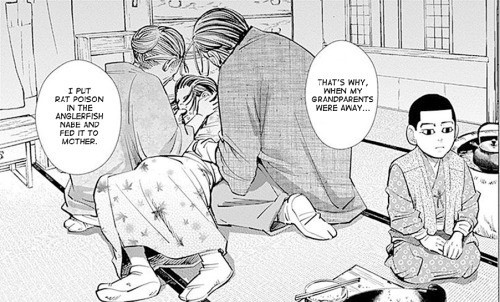
As a result Hyakunosuke is brought up by his grandparents alone. He likes his grandma. They might instill in him the same kind of dislike for the new government as in the case of Kadokura. They definitely install a dislike for his deadbeat dad.
* Japan sent most of the promising officers abroad to soak up the knowledge how to run a modern nation. The army was mostly modeled after Germany (the Japanese were impressed by their recent victory against France) so it's the safest bet that Koujirou went to study there sometime in his life. In 1887-88 Nogi and Soroku Kawakami were sent to Germany. So it still depends if Nogi exists in GK universe and Koujirou just tagged along with them, or are they completely interchangeable.
1888
A new division is formed in Hokkaido. Tasked with guarding the north and developing the land.
1889
Heinojou (16) passes the Naval Academy entry exams with highest marks, determined to follow the footsteps of his father.
1894-95
The first Sino-Japanese war breaks out.
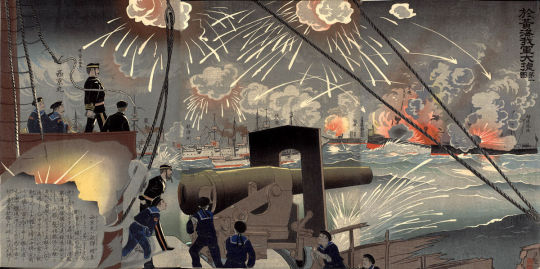
Heiji and Heinojou take part in the Battle of Yalu River. Heinojou is stationed on the flagship Matsushima under admiral Ito Sukeyuki. Matsushima gets badly damaged. 57 men die (including three officers) and 54 more are wounded.
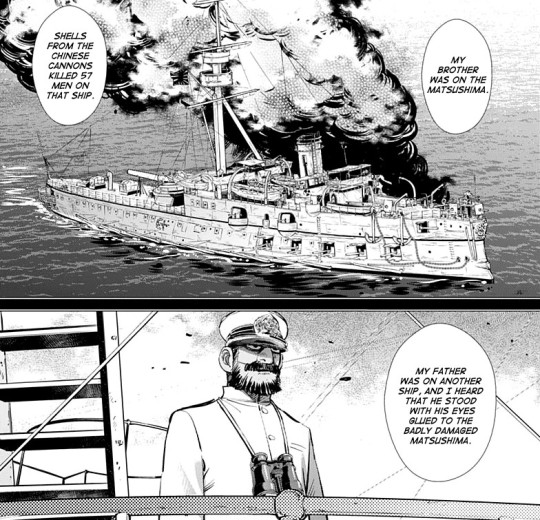
Heiji silently watches his son burning from his ship. Comes back a wreck of a man. Gets awarded a title of Baron under the kazoku system *.
No clue what Koujirou could have been doing then. It’s likely that he was part of the army that conquered Port Arthur (back than still called Lushunkou) the first time around in only 3 days **.

* I need to double-check that with the raws since I'm not sure Tsurumi calling him "lord" is meant to imply he had a noble title, or if it's just a honorific. Many of admirals had titles so it would be highly likely someone with a lineage and a service record like Heiji also got one.
** this experiance would make him a pefect choice for later leading the operation in 1904 so this would make a lot of sense, but it would also be a pretty heavy take, since that would mean he was present during the Port Arthur masacre. And as a senior officer too, so it’s hard to find any excuses for him if that was the case.
Did witnessing the atrocities there influence his later opposition to the Japanese expansion into Manchuria? Was his instruction for Yuusaku not to kill anyone motivated by trying to protect his son from sharing his guilt?
1895
Tsurumi comes back from the war and joins the 7th (actually more like he’s demoted out of the 2nd). By then Koujirou is the head of the division *
* I’m guessing Tsurumi had to have enough time to work on him, to be able to learn all about the Koito family troubles and come up with the plan how to use them. Did he get into Koujirou’s confidence? Or was he just reading his private letters?
1900
Heiji stays in Kagoshima and spoils/neglects his second son. Tsurumi "accidentally" meets Otonoshin and they visit Saigo's and Heinojou's graves.
Later that year the whole Koito family moves to Hakodate and Heiji takes control of the Ominato torpedo division *.
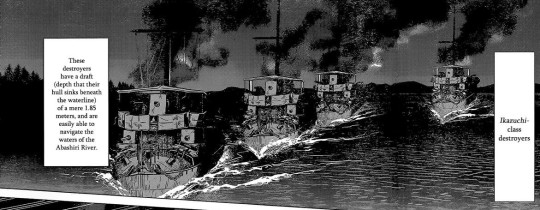
* The Ikazuki was a new class of light destroyers specifically made not to repeat the tragedy of too large and too slow Matsushima. No wonder Heiji was willing to move across the country for that.There were 6 of them made in total. Cool factoid: One of those destroyers sunk after a crash with a civilian steamship off the coast of Hokkaido in 1909.
1902
Ogata (24) joins the army and specifically volunteers for the 7th division planning god-knows-what. By conscription he would have landed in the 2nd (Kantou region).
Koujirou doesn't acknowledge him. Tsurumi does.
The Great Hakodate kidnapping takes place. Koujiro sends his best intelligence officer from Tsukisappu to help his friend and keep things discreet. Afterwards Heiji learns to appreciate the son he has left.
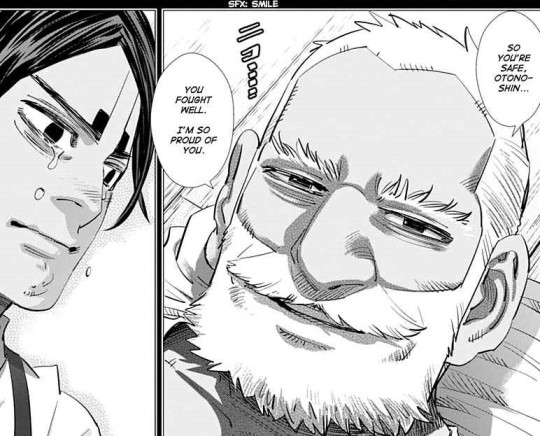
Later that year Otonoshin passes the exam to join the Army acedemy.
Fresh out of the academy Yuusaku (21) joins the 7th division. His father, plagued with guilt and bad life choices instructs him not to kill people and not to sleep around.
Yuusaku meets Hyakunosuke. Hyakunosuke tries to get him to kill people and sleep around.

1904-05
The Russo-Japanese war.

In February the war starts with Japan launching night torpedo attacks on the Russian fleet stationed inside Port Arthur. Heiji leads the third destroyer squadron aboard the Sazanami*. They continue the attacks over the next months trying to impose a blockade. After the Battle of the Yellow Sea, the victorious Japanese Combined Fleet effectively traps the remaining Russian warships inside Port Arthur. The Russians can't get out, the Japanese can't get in. Heiji can only wait and watch as the Japanese Army struggles to capture Port Arthur by land.

Koujirou leaves the 7th division behind when he is promoted to a member of staff of General Nogi’s 3rd Army. They land in Incheon in April and reach Port Arthur in August to start the siege. It is a drawn out blood bath. After wasting tons of lives in pointless assaults, the Japanese realize quite late that the key to victory lies in capturing the 203 Hill overlooking the harbor. Koujirou is made chief of staff for this operation.
In October they get the news that the Russian Baltic Fleet has left Tallinn and is on its way to reinforce the besieged Pacific Fleet. The race starts. If Koujirou fails to capture the hill before the Baltic Fleet arrives, the Japanese Fleet will be annihilated, and Heiji along with it.
In November the 7th division arrives in Port Arthur. They don’t get special treatment from their former commander and they’re sent head first to the 203 Hill. They capture it on 5th December, only after the artillery stopped caring weather they hit their own or not**. From their new position they destroy the whole Pacific fleet.

The death toll is 80 000 soldiers. More than half of the 7th is gone. Among the fallen are second lieutenants Hanazawa Yuusaku and Nogi Yasusuke - general Nogi's only remaining son (the first one died earlier in the same war).***
Hyakunosuke thinks that the losses wouldn't have to be this high if they just had more snipers like him. But nobody listened.

* All of the Ikazuki-class destroyers were quite active during the war. I placed Heiji on the Sazanami just because there’s the most info about what she did and when.
** The winning strategy was implemented by Kodama Gentarou. He was sent to Port Arthur with the authority to replace Nogi. He had enough guts to sacrifice soldiers falling to friendly fire in one coordinated assault instead of bleeding them out by continuous suicidal frontal assaults. He didn't officially replace Nogi though, and he let him take the credit for the victory, because they were friends. It's a really cool story.
*** Interesingly enough Yasusuke, was also shot in the back of his head. His father when he saw his body asked only “Was it after he had completed his task, or was it before?”
1905
The 7th move on to Mukden. Koujirou and Nogi along with them.
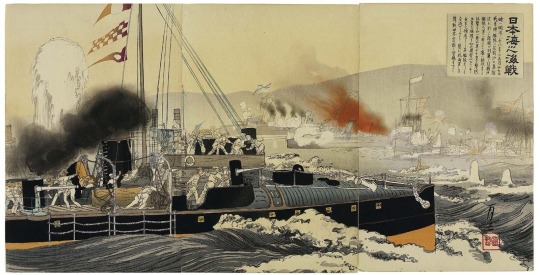
In May the Baltic Fleet arrives. Without Port Arthur, they try to get to Vladivostok to resupply. Tougou's fleet intercepts them in the Tsushima strait and despite their smaller number, crushes them decisively. Heiji's destroyer Sazanami, captures the destroyer Buyini with the wounded admiral Zinovy Rozhestvensky **.
In September the Treaty of Portsmouth is signed. The Trans-Manchurian Railway gets handed off to the Japanese. Later Koujirou strongly opposes the plan to develop it ***.
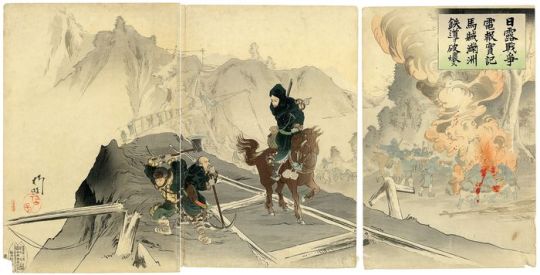
** Heiji's torpedo division was also responsible to delivering the finishing blow to the flagship Knyaz Suarov. Later this was written on Knyaz Suarov's last moments "While she had a gun above water she fired, and not a man survived her of all that crew, to whose stubborn gallantry no words can do justice. If there is immortality in naval memory it is hers and theirs". Gives me the chills.
*** Did he see that it would lead to more war? Mantetsu was the reason behind the Manchurian Incident in 1931 and later for the breakout of the second Sino-Japanese war, where a really ugly face of Japanese imperialism saw the light of day. So, was Koujirou a good guy all along? This I hope will be explained in the manga.
1906
In January Nogi returns to give a victory report to the Emperor *.
Koujirou "commits seppuku" by his son's hand. "Writes" a sappy goodbye letter to Heiji (probably also by Ogata's hand).

Heiji gets seduced by his son's dashing young commander and does some stupid-treasonous things for him, convinced that Central Command was to blame for pushing Koujirou to suicide.
In November Mantetsu is established.
* Nogi breaks down while making the report and asks to be allowed to commit seppuku for allowing such high casualties. The Emperor forbids him. Nogi waits 7 years until the Emperor dies and commits seppuku on the day of his funeral.
Disclaimers
I would say half of this consists of what already is in GK canon (even if it’s written between the lines) or history. The other half are my free guesses for what I personally think would make a better story ;)
I tried and tried to do thorough research, but in the end I’m just a humble fangirl, and not a historian, so if there’s something I got wrong, missed or misinterpreted please correct me - learning history is a never-ending story.
Sorry for linking directly to the scanlations. Support the manga by buying the volumes if you can.
This list will most likely be growing since I will eventually figure out what Koujirou did during the Sino-Japanese war, and I’m only starting digging in to the details of the Boshin War, so I’m sure I’ll expand upon that.
If anyone ever wants to use this information for a fic, please do. Copy it all if you want to. I don’t mind the slightest. I’ll love you to pieces for writing anything for them at all!
136 notes
·
View notes
Text
To the death of the commander
Allow me to drop you a few lines. I hope you are in good health during this rainy season.
But as for our commander, Hijikata, after the retreat from Edo, he led the first detachment of Denshutai and captured Utsunomiya in Yashu; after which he was wounded in battle, and recuperated in Aizu until he had fully recovered from his wound. There he commanded the Eastern Front, and did his utmost to prevent the surrender of Aizu Castle, but defeat was inevitable. Then he retreated to Sendai, where he met with with the Most Serene Prince, who gave him a katana. From there our commander was going to lead the army to Fukushima, but this campaign did not take place, because Sendai decided to surrender.
In the tenth month of the year of the Dragon, having sworn to Admiral Enomoto, the commander went with him to Ezo, where he became commander-in-chief of the ground forces and chairman of the naval tribunal. In the fourth month of the Year of the Snake, when our other troops were suffering defeats, he won a crushing victory at a place called Futamata. He then repeatedly fought successful battles, but in Matsumae County, the enemy broke through the defense line and we were forced to retreat.
On May 11 of this year, in the battle for Hakodate, our commander led the troops on the outskirts of the city, at the gates of Ippongi, and there he fell in battle, which I inform you with sincere regret and regret.
As for me, I am still alive, but it is a dubious honor. A council of war will be held today in our besieged fortress, and no matter what is decided at the council, I am prepared to die in battle. Therefore Tachikawa Chikara, who has been with the commander from beginning to end, will sneak out of Goryokaku, deliver this letter to you, and tell you everything in detail. I'll entrust it to him.
The enemy's attack is approaching soon, so please forgive my careless handwriting. In any case, I hasten to notify you and ask you to accept this news.
Respectfully yours sincerely,
Yasutomi Saisuke Masayoshi
May 12
Hijikata Hayato-sama
Please take care of yourself and give my best regards to everyone you can.
To the death of the commander:
Is there enough strength
Overcome the raging current?
It carries a fish...
Sealed May 16
To the outskirts of Hino-juku, Hijikata Hayato-sama
From Goryokaku Fortress, by Yasutomi Saisuke
Notes:
Denshutai was a detachment organized by Otori Keisuke in 1867, based on the French model. In April 1868, the Shinsengumi, led by Hijikata, joined it.
I have not been able to find out yet what "Most Serene Prince" Hijikata met in Sendai. Yasutomi writes "大君 " (o-kimi), meaning "emperor, sovereign, shogun", but most likely a daimyo from among the representatives of the Northern Alliance. Possibilities include Matsudaira, the daimyo of Sendai, Prince Yoshihisa.
About "chairman of the naval tribunal", I'm not sure exactly how it is translated, in Japanese it is literally "of the land army and navy chairman of the court".
Hijikata Hayato was the head of the Hijikata family at the time, Toshizo's nephew. "Hayato" was a hereditary name in their family, it was carried by Hijikata's father, then older brother Kiroku, but he died in 1860 and the name passed to Kiroku’s son Yoshihiro.
However, the Hijikatas seem to have lived in Ishida village, and Sato Hikogoro lived in Hino-juku, to whom the letter eventually went.
Haiku in original Japanese:
早き瀬に力
足らぬか
下り鮎
Ayu fish (the fish mentioned in the poem) live in rivers and lakes and go to the sea in winter. They live only one year, rarely two or three. Eggs are laid in rivers in the fall, and hatched fry are immediately carried away to the sea, where they spend the entire winter, and by spring grow up and return to the rivers.
A very common fish in Japan. Hijikata caught one in his native river Kamogawa, about which he wrote about in one of his haiku [T/N: the haiku mentioned the Tama River in Hino instead of the Kamo River in Kyoto]. There are assumptions that the author of the haiku in this letter is none other than Hijikata. In favor of this, the Japanese themselves put forward two good reasons:
1) It is inappropriate to call a commander an ayu fish, much less compare him to a helpless fry (see the cyclical nature of ayu life).
2) Haiku, as we know, should have words that reflect the seasons. Poems in spring are about spring, poems in fall are about fall. And here, veiled, a poem in spring is about fall (see above).
But this is just speculation. Perhaps Yasutomi Saisuke wrote in spring about fall to emphasize how he was grieving. And what about the fish - it may have been his own death poem, which he dedicated to his commander at the same time.
2 notes
·
View notes
Text
1/200 CSS Stonewall - Paper Model
Publisher: Heinkel Models
Kōtetsu, later renamed Azuma, was the first ironclad warship of the Imperial Japanese Navy. Built in Bordeaux, France in 1864 for the Confederate States Navy as CSS Stonewall, and acquired from the United States in February 1869, she was an ironclad ram warship. She had a decisive role in the Naval Battle of Hakodate Bay in May 1869, which marked the end of the Boshin War, and the complete establishment of the Meiji Restoration.
This model is a representation in the Confederate period.
Paper Model Details: Over 230 parts on five part pages and on page of formers. Full-hull and waterline option. Sails. Japanese Ironclad version. Display stand, three pages of construction diagrams. Bulkhead-and-joiner-strip construction.
Pdf version of the publication of the publisher Pro-arte.
Price: $10.63
1/200 CSS Stonewall - Paper Model published first on https://supergalaxyrom.tumblr.com
0 notes
Text
ii~hakodate🌸函館
Blinded by the overwhelming urgency the historic disruption had left, Airi had neglected any sort of preparation, a shortcoming that unsettled her as the light of the time dial faded, leaving the three of them in the outskirts of a harbour city. As he reverted to his human form in a flourish of petals, the sword surveyed their destination, a frown on his lips.
“What’s the situation?”
Lips parted, ready to answer, only to bite down in a grimace, fighting nausea as Omoikane’s gift flared. Words churning, coalescing, colourizing into shifting images. Ships upon the water, the burst of cannon fire reverberating over the waves, figures scurrying across the decks. A darkness, a sickly black-flecked sanguine purple, ate at the bizarre vision like some malignant disease; again, that same ripple she’d felt in the shrine and a grainy static ringing in her ears. When the vertigo lifted, the saniwa found herself steadied by Yamanbagiri’s firm grip, which he promptly released once she’d steadied herself.
"Head for the port. Six of them will be arriving shortly. Konnosuke, today’s date is May 3rd, 1869, correct?”
"Yes, Master!”
“They’re going to interfere with the naval battle that breaks out tomorrow. Brief Yamanbagiri on the events. Yamanbagiri, I reiterate your directive: find and destroy any member of the History Retrograde Army, and thus protect the course of history.”
Hakodate, city of the Ezo Republic's, a pseudo-government consisting of the former Tokugawa shogunate forces, last stand. It was here that the end of an era and the beginning of a new one met. Faced with bad luck and superior weaponry, the Republic had lost the conflict, a defeat which had followed them back to shore, where they had ultimately surrendered their two key fortresses almost a month later. Small wonder that the History Retrograde Army would target this event, but why would they interfere in the way she’d foreseen?
Whether she felt or heard the time-space distortion first, neither were entirely certain, but the moment a ring of light yawned open overhead, both of them knew this was the foe they sought. Half a dozen bolts of blood red lightning dropped from the gaping hole in the sky, urging the pair into a full sprint down the street. The moment they rounded the corner and came into view of the enemy, however, Airi felt her stomach knot into a ball of dread. Even a layman could distinguish that these were nothing short of monstrous. Great horns, like those of a demon, curved up from their flat serpentine heads, pinpricks of light glinting eerily from empty sockets. Orochi? No, and despite their appearance they lacked the telltale mark of Yomi. Tsukumogami? That wasn’t quite right either; they felt altered, as if halfway to becoming something closer to a vengeful spirit.
Any further deliberation of their identity was cut short when one of them gurgled out a hollow hiss and the air was suddenly alive with the rasp of stained bone. Airi tensed and reflexively reached for her kodachi, only for one of Yamanbagiri’s larger hands to cover hers, firmly pushing the partially-drawn blade back into its scabbard. Then he was front and center, his own weapon humming as he leapt in to intercept and join battle. Uchigatana met tantou in a small spurt of sparks, his larger, heavier armament easily pushing the creature aside. Steel shrieking through bone; half of a skeletal body flew, still writhing as it dissolved into a shower of fell miasma and ash. Another clash of steel against steel, and this time there was a sharp crystalline snap as the touken danshi’s blow bit into the injured beast’s knife and clove it in twain, an ear-splitting shriek rocketing through the mostly empty avenue as it corroded into nothingness.
Though their earlier interaction had made it clear the blond had wanted no assistance, his saniwa had kept her grip on the handle of her kodachi. She had been cautioned that the manifested spirits would likely require time and experience to adapt to the full intricacies of a form of flesh. His original vessel granted the advantage of reach and strength, but his was a human body newly formed. Against these current numbers, did he have the ability to overpower them? There was something in their energy, the way they wielded the daggers in their fanged jaws, that strengthened the woman’s suspicion that they were some kind of tsukumogami gone terribly wrong.
And terribly wrong was the condition the battle rapidly deteriorated to. As if to confirm her fears, the rest of the skeletal serpents, neither orochi nor tsukumogami nor onryou, began to display a level of intellect and cunning their appearances belied. Skilled as the cloaked warrior was, he was outnumbered and a bigger target, unable to fend off all five of the remaining foes at once. Line after crimson line raced across his body as Yamanbagiri swatted bravely at the aberrations that circled him like flies. Their superior agility kept his blows from being fatal, and his injuries were slowing him, gradually sapping at his strength.
A defiant snarl curled out from behind gritted teeth as the air around the blond seemed to suddenly shift even as Airi locked her thumb under the guard of her sword. For a moment she thought she saw Yamanbagiri’s blade shimmer with iridescent light, but in the next blink it was gone, the touken danshi tilting into a headlong retaliation. If he felt the smaller swords cutting into him, it didn’t show, his blue gaze burning with predatory determination. His attack struck true, caving in one snake head in a shower of dark mist and splintered bone. One creature had its tail, then the rest of its body severed in quick succession. Another that came too close found its horns separated from its bony head moments before the light from its vacant sockets guttered out as its knife shattered from the force of the next blow.
Any burgeoning hope that whatever battle fever-like state the uchigatana had entered could turn the tide of battle instantly vanished with the strangled grunt that escaped his lips. One of the tantou-wielding serpents had taken advantage of his exposed rear to rake its weapon deeply across his back, the other ramming him point-first in the gut barely a breath later. This time the gagging cough came out a dark, thick ruby. Stumbling, he batted his attackers away, but they simply circled back around, each aimed for a vital.
“Naoshi!”
Kotodama thundering, bass rippling like a shockwave, she leapt forward, kodachi leaving its sheath in a singing silver arc. Blade collided with blade in a crash of sparks as a bestial roar echoing her cry rumbled out from behind. A heavy obsidian paw caught the other demonic thing squarely on its ribcage, slamming it bodily into the ground with a resounding crunch. Forcing her opponent back, Airi struck once, twice, thrice, each time shaving chunks away from its bony frame. Had she not had the weight of an adult man sagging against her other arm her fight would have been over, but as it was her only warrior was bleeding out all over her, and the loss of strength behind her swings showed. As she drew back to meet the tantou once more, attention aimed for the gap where she’d sheared off a few ribs, it was not her blade, but a longer sword that rammed itself up from the monstrosity’s lower jaw through its skull. There was a grating yowl as it disintegrated, and the saniwa had to brace as the uchigatana’s knees buckled beneath him.
"Yamanbagiri, you--!”
"Don’t give me that,” he wheezed, mouth smeared with crimson. “I don’t know how this whole manifestation thing works but I’d rather not find out on our very first day.”
“I was in no danger! You, on the other hand--”
"It’s fine. Being bloodied up like this is perfect for me.” His tone was clipped, azure eyes still blazing with the same fire he’d displayed earlier. “Is that all of them? What was their goal?”
"...They were going to sabotage and attack the neutral European ships that would be watching the naval battle,” she explained, catching the hand he was using to push her away and turning him around instead to start binding his most severe injuries with strips torn from her sleeve. “Konnosuke, report.”
“R-right! There were no major changes to history, as the foreign ships remained untouched.”
"They won’t come back for a while. We had the element of surprise today... not for long, though.” One deft tug tightened the knot on the makeshift bandaging, and she shouldered the blond’s weight. “Your first mission is complete. We’re headed back.”
0 notes
Text
1869-Battle of Hakodate
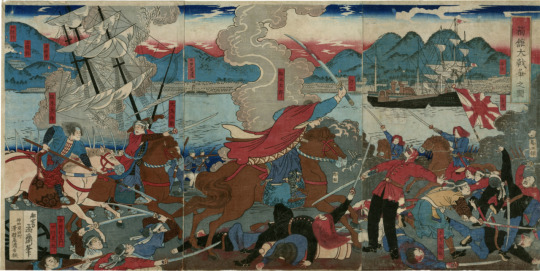
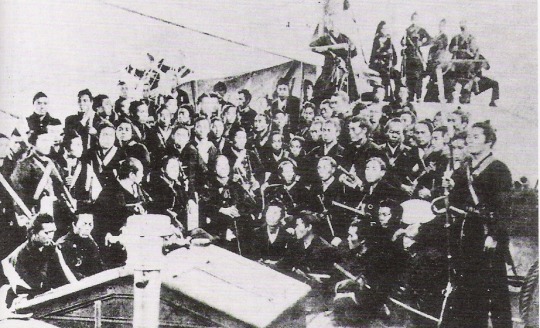
The Battle of Hakodate (箱館戦争, Hakodate Sensō) was fought in Japan from December 4, 1868 to June 27, 1869, between the remnants of the Tokugawa shogunate army, consolidated into the armed forces of the rebel Ezo Republic, and the armies of the newly formed Imperial government (composed mainly of forces of the Chōshū and the Satsuma domains). It was the last stage of the Boshin War, and occurred around Hakodate in the northern Japanese island of Hokkaidō.
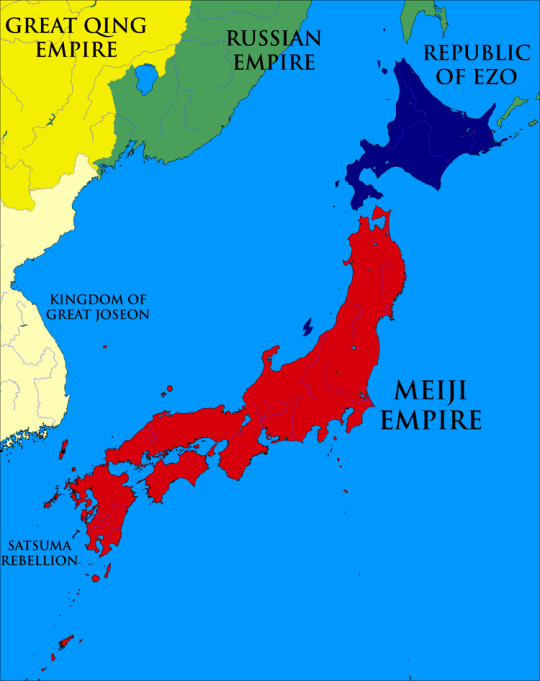
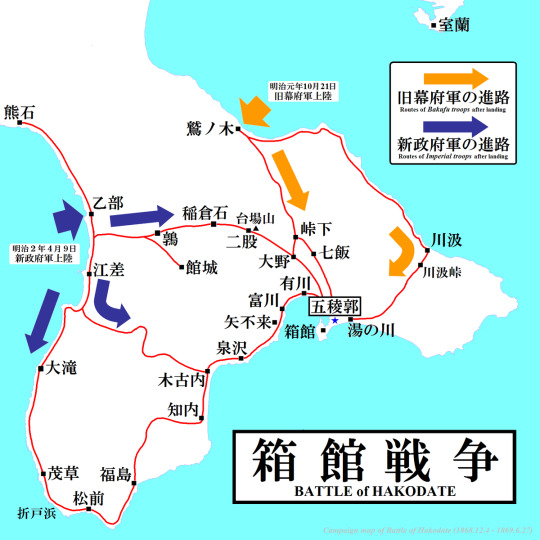
The Imperial troops, numbering 7,000, finally landed on Hokkaidō on April 9, 1869. They progressively took over various defensive positions, until the final stand occurred around the fortress of Goryōkaku and Benten Daiba around the city of Hakodate.
Japan's first major naval engagement between two modern navies, the Naval Battle of Hakodate Bay, occurred towards the end of the conflict, during the month of May 1869.[1]
After having lost close to half their numbers and most of their ships, the military of Ezo Republic surrendered to the Meiji government on June 27, 1869.
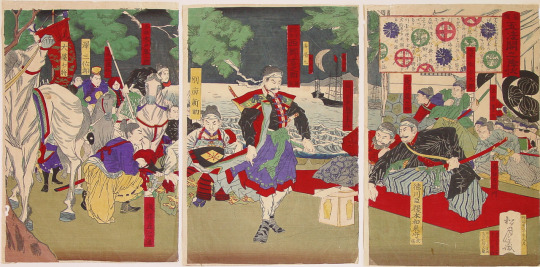
The battle marked the end of the old feudal regime in Japan, and the end of armed resistance to the Meiji Restoration. After a few years in prison, several of the leaders of the rebellion were rehabilitated, and continued with brilliant political careers in the new unified Japan: Enomoto Takeaki in particular took various ministry functions during the Meiji period.

The new Imperial government, finally secure, established numerous new institutions soon after the end of the conflict. The Imperial Japanese Navy in particular was formally established in July 1869, and incorporated many of the combatants and ships which had participated in the Battle of Hakodate.
2 notes
·
View notes
Text
Events 6.4
1256 – The Augustinian monastic order is constituted at the Lecceto Monastery when Pope Alexander IV issues a papal bull Licet ecclesiae catholicae.
1415 – Religious reformers John Wycliffe and Jan Hus are condemned as heretics at the Council of Constance.
1436 – Assassination of the Swedish rebel (later national hero) Engelbrekt Engelbrektsson
1471 – Wars of the Roses: The Battle of Tewkesbury: Edward IV defeats a Lancastrian Army and kills Edward of Westminster, Prince of Wales.
1493 – Pope Alexander VI divides the New World between Spain and Portugal along the Line of Demarcation.
1626 – Dutch explorer Peter Minuit arrives in New Netherland (present day Manhattan Island) aboard the See Meeuw.
1686 – The Municipality of Ilagan is founded in the Philippines.
1776 – Rhode Island becomes the first American colony to renounce allegiance to King George III.
1799 – Fourth Anglo-Mysore War: The Battle of Seringapatam: The siege of Seringapatam ends when the city is invaded and Tipu Sultan killed by the besieging British army, under the command of General George Harris.
1814 – Emperor Napoleon arrives at Portoferraio on the island of Elba to begin his exile.
1814 – King Ferdinand VII abolishes the Spanish Constitution of 1812, returning Spain to absolutism.
1836 – Formation of Ancient Order of Hibernians
1859 – The Cornwall Railway opens across the Royal Albert Bridge linking Devon and Cornwall in England.
1869 – The Naval Battle of Hakodate is fought in Japan.
1871 – The National Association, the first professional baseball league, opens its first season in Fort Wayne, Indiana.
1886 – Haymarket affair: In Chicago, United States, a homemade bomb is thrown at police officers trying to break up a labor rally, killing one officer. Ensuing gunfire leads to the deaths of a further seven officers and four civilians.
1904 – The United States begins construction of the Panama Canal.
1910 – The Royal Canadian Navy is created.
1912 – Italy occupies the Ottoman island of Rhodes.
1919 – May Fourth Movement: Student demonstrations take place in Tiananmen Square in Beijing, China, protesting the Treaty of Versailles, which transferred Chinese territory to Japan.
1926 – The United Kingdom general strike begins.
1927 – The Academy of Motion Picture Arts and Sciences is incorporated.
1932 – In Atlanta, mobster Al Capone begins serving an eleven-year prison sentence for tax evasion.
1942 – World War II: The Battle of the Coral Sea begins with an attack by aircraft from the United States aircraft carrier USS Yorktown on Japanese naval forces at Tulagi Island in the Solomon Islands. The Japanese forces had invaded Tulagi the day before.
1945 – World War II: Neuengamme concentration camp near Hamburg is liberated by the British Army.
1945 – World War II: The German surrender at Lüneburg Heath is signed, coming into effect the following day. It encompasses all Wehrmacht units in the Netherlands, Denmark and northwest Germany.
1946 – In San Francisco Bay, U.S. Marines from the nearby Treasure Island Naval Base stop a two-day riot at Alcatraz Federal Penitentiary. Five people are killed in the riot.
1949 – The entire Torino football team (except for two players who did not take the trip: Sauro Tomà, due to an injury and Renato Gandolfi, because of coach request) is killed in a plane crash.
1953 – Ernest Hemingway wins the Pulitzer Prize for The Old Man and the Sea.
1959 – The 1st Annual Grammy Awards are held.
1961 – American civil rights movement: The "Freedom Riders" begin a bus trip through the South.
1961 – Malcolm Ross and Victor Prather attain a new altitude record for manned balloon flight ascending in the Strato-Lab V open gondola to 113,740 feet (34.67 km).
1970 – Vietnam War: Kent State shootings: The Ohio National Guard, sent to Kent State University after disturbances in the city of Kent the weekend before, opens fire killing four unarmed students and wounding nine others. The students were protesting the Cambodian Campaign of the United States and South Vietnam.
1972 – The Don't Make A Wave Committee, a fledgling environmental organization founded in Canada in 1971, officially changes its name to "Greenpeace Foundation".
1973 – The 108-story Sears Tower in Chicago is topped out at 1,451 feet (442 m) as the world's tallest building.
1978 – The South African Defence Force attacks a SWAPO base at Cassinga in southern Angola, killing about 600 people.
1979 – Margaret Thatcher becomes the first female Prime Minister of the United Kingdom.
1982 – Twenty sailors are killed when the British Type 42 destroyer HMS Sheffield is hit by an Argentinian Exocet missile during the Falklands War.
1988 – The PEPCON disaster rocks Henderson, Nevada, as tons of Space Shuttle fuel detonate during a fire.
1989 – Iran–Contra affair: Former White House aide Oliver North is convicted of three crimes and acquitted of nine other charges; the convictions are later overturned on appeal.
1990 – Latvia declares independence from the Soviet Union.
1994 – Israeli Prime Minister Yitzhak Rabin and PLO leader Yasser Arafat sign a peace accord, granting self-rule in the Gaza Strip and Jericho.
1998 – A federal judge in Sacramento, California, gives "Unabomber" Theodore Kaczynski four life sentences plus 30 years after Kaczynski accepts a plea agreement sparing him from the death penalty.
2000 – Ken Livingstone becomes the first Mayor of London (an office separate from that of the Lord Mayor of London).
2002 – One hundred three people are killed and 51 are injured in a plane crash near Mallam Aminu Kano International Airport in Kano, Nigeria.
2007 – Greensburg, Kansas is almost completely destroyed by a 1.7-mile wide EF5 tornado. It was the first-ever tornado to be rated as such with the new Enhanced Fujita scale.
2014 – Three people are killed and 62 injured in a pair of bombings on buses in Nairobi, Kenya.
2019 – The inaugural all-female motorsport series, W Series, takes place at Hockenheimring. The race was won by Jamie Chadwick, who would go on to become the inaugural season's champion.
2023 – Eight people are killed and fourteen injured in a spree shooting in Mladenovac and Smederevo, Serbia. It is the second mass shooting in the country in two days.
0 notes
Text
Events 5.4
1256 – The Augustinian monastic order is constituted at the Lecceto Monastery when Pope Alexander IV issues a papal bull Licet ecclesiae catholicae.
1415 – Religious reformers John Wycliffe and Jan Hus are condemned as heretics at the Council of Constance.
1436 – Assassination of the Swedish rebel (later national hero) Engelbrekt Engelbrektsson
1471 – Wars of the Roses: The Battle of Tewkesbury: Edward IV defeats a Lancastrian Army and kills Edward of Westminster, Prince of Wales.
1493 – Pope Alexander VI divides the New World between Spain and Portugal along the Line of Demarcation.
1626 – Dutch explorer Peter Minuit arrives in New Netherland (present day Manhattan Island) aboard the See Meeuw.
1686 – The Municipality of Ilagan is founded in the Philippines.
1776 – Rhode Island becomes the first American colony to renounce allegiance to King George III.
1799 – Fourth Anglo-Mysore War: The Battle of Seringapatam: The siege of Seringapatam ends when the city is invaded and Tipu Sultan killed by the besieging British army, under the command of General George Harris.
1814 – Emperor Napoleon arrives at Portoferraio on the island of Elba to begin his exile.
1814 – King Ferdinand VII abolishes the Spanish Constitution of 1812, returning Spain to absolutism.
1836 – Formation of Ancient Order of Hibernians
1859 – The Cornwall Railway opens across the Royal Albert Bridge linking Devon and Cornwall in England.
1869 – The Naval Battle of Hakodate is fought in Japan.
1871 – The National Association, the first professional baseball league, opens its first season in Fort Wayne, Indiana.
1886 – Haymarket affair: In Chicago, United States, a homemade bomb is thrown at police officers trying to break up a labor rally, killing one officer. Ensuing gunfire leads to the deaths of a further seven officers and four civilians.
1904 – The United States begins construction of the Panama Canal.
1910 – The Royal Canadian Navy is created.
1912 – Italy occupies the Ottoman island of Rhodes.
1919 – May Fourth Movement: Student demonstrations take place in Tiananmen Square in Beijing, China, protesting the Treaty of Versailles, which transferred Chinese territory to Japan.
1926 – The United Kingdom general strike begins.
1927 – The Academy of Motion Picture Arts and Sciences is incorporated.
1932 – In Atlanta, mobster Al Capone begins serving an eleven-year prison sentence for tax evasion.
1942 – World War II: The Battle of the Coral Sea begins with an attack by aircraft from the United States aircraft carrier USS Yorktown on Japanese naval forces at Tulagi Island in the Solomon Islands. The Japanese forces had invaded Tulagi the day before.
1945 – World War II: Neuengamme concentration camp near Hamburg is liberated by the British Army.
1945 – World War II: The German surrender at Lüneburg Heath is signed, coming into effect the following day. It encompasses all Wehrmacht units in the Netherlands, Denmark and northwest Germany.
1946 – In San Francisco Bay, U.S. Marines from the nearby Treasure Island Naval Base stop a two-day riot at Alcatraz Federal Penitentiary. Five people are killed in the riot.
1949 – The entire Torino football team (except for two players who did not take the trip: Sauro Tomà, due to an injury and Renato Gandolfi, because of coach request) is killed in a plane crash.
1953 – Ernest Hemingway wins the Pulitzer Prize for The Old Man and the Sea.
1959 – The 1st Annual Grammy Awards are held.
1961 – American civil rights movement: The "Freedom Riders" begin a bus trip through the South.
1961 – Malcolm Ross and Victor Prather attain a new altitude record for manned balloon flight ascending in the Strato-Lab V open gondola to 113,740 feet (34.67 km).
1970 – Vietnam War: Kent State shootings: The Ohio National Guard, sent to Kent State University after disturbances in the city of Kent the weekend before, opens fire killing four unarmed students and wounding nine others. The students were protesting the Cambodian Campaign of the United States and South Vietnam.
1972 – The Don't Make A Wave Committee, a fledgling environmental organization founded in Canada in 1971, officially changes its name to "Greenpeace Foundation".
1973 – The 108-story Sears Tower in Chicago is topped out at 1,451 feet as the world's tallest building.
1978 – The South African Defence Force attacks a SWAPO base at Cassinga in southern Angola, killing about 600 people.
1979 – Margaret Thatcher becomes the first female Prime Minister of the United Kingdom.
1982 – Twenty sailors are killed when the British Type 42 destroyer HMS Sheffield is hit by an Argentinian Exocet missile during the Falklands War.
1988 – The PEPCON disaster rocks Henderson, Nevada, as tons of Space Shuttle fuel detonate during a fire.
1989 – Iran–Contra affair: Former White House aide Oliver North is convicted of three crimes and acquitted of nine other charges; the convictions are later overturned on appeal.
1990 – Latvia declares independence from the Soviet Union.
1994 – Israeli Prime Minister Yitzhak Rabin and PLO leader Yasser Arafat sign a peace accord, granting self-rule in the Gaza Strip and Jericho.
1998 – A federal judge in Sacramento, California, gives "Unabomber" Theodore Kaczynski four life sentences plus 30 years after Kaczynski accepts a plea agreement sparing him from the death penalty.
2000 – Ken Livingstone becomes the first Mayor of London (an office separate from that of the Lord Mayor of London).
2002 – 103 people are killed and 51 are injured in a plane crash near Mallam Aminu Kano International Airport in Kano, Nigeria.
2007 – Greensburg, Kansas is almost completely destroyed by a 1.7-mile wide EF5 tornado. It was the first-ever tornado to be rated as such with the new Enhanced Fujita scale.
2014 – Three people are killed and 62 injured in a pair of bombings on buses in Nairobi, Kenya.
2019 – The inaugural all-female motorsport series, W Series, takes place at Hockenheimring. The race was won by Jamie Chadwick, who would go on to become the inaugural season's champion.
1 note
·
View note
Text
Ramblings and crazy theory time about GK chap 198 “Otonoshin’s Tricycle”
The new chapter is out and so let’s dig into the second part of Koito’s past.
To be a relatively new character (he was introduced in vol 10) Koito is getting quite a long flashback space considering characters like Tanigaki or Tsukishima only had a two chapters flashback... but I think this is because this flashback isn’t just about him and his motivations but it’s working as a setting for future developments.
Anyway we resume where we left, with Koito staring at his brother’s grave… filled with dark thoughts like that he’s the failure of the Koito family and can’t become his brother’s replacement…
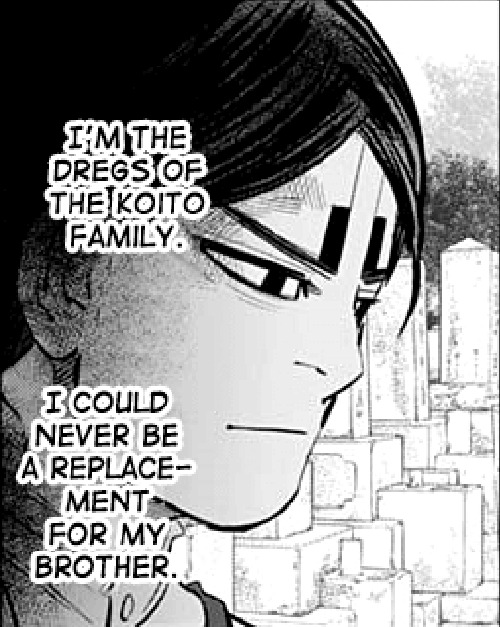
...while Tsurumi wants to take advantage of the moment he has carefully created to push him to open his heart to him so as to gain more of his trust.
Really, Tsurumi is amazing as a manipulator… telling young Koito it would be better if he were to let out what he’s holding in he sounds so nice and caring…

Koito though, resists a bit, admitting he said too much to someone he just met… which was wise. Too bad he’s up against Tsurumi (was Tsurumi smiling when Koito refused to speak up further? I’m not really sure due to the ballons hiding part of his face... but can it be things are going EXACTLY as he predicted and even Koito’s resistance was part of the plan? Considering the editor’s words ‘I know the words you want to hear’ I’ll say he too thinks so)… who hurries to point out Koito shouldn’t feel obliged to replace his brother in his father’s eyes.

Have I already mentioned how Tsurumi amazes me?
Even though Koito refused to open up, Tsurumi’s answer is the perfect answer to Koito’s inner monologue. Koito WAS feeling like an unfitting replacement for his brother and Tsurumi told him he didn’t have to be one.
True, Tsurumi lead him to this point but it’s still amazing how he has done it.
Koito’s reaction is one of surprise as it’s very likely no one ever told him this or understood how he felt.

Probably they all expected him to replace his brother and, at the same time, criticized him because he wasn’t up on the task.
In short he was at the same time pressured into replacing his brother and yet not trusted to be capable to do so, as if following in his brother’s footsteps was merely a fool’s errand if handed to him.
It should have felt quite sad and depressing.
Or maybe the poor boy never realized it wasn’t his duty to preplace his brother. It’s still rather sad.
And finally we can see what’s written on his brother’s grave.
Tsurumi reads it for us. Koito’s brother was the navy ensign Koito Heinojou (鯉登 平之丞), who died in Meiji 27 or, if you prefer in 1894, Sept. 17th, which is the date of the battle of Yalu River, a naval battle in the Sino-Japanese war.

Attentive readers might notice the first kanji in his name is also the first kanji in his father’s name, Koito Heiji (鯉登平二), which hints at how Heinojou, being the firstborn, was meant to take his father’s place and continue his line.
According to Sei Kobiyama Heinojou means “the heir of Heiji 平二 and descendant of Samurai” as Nojou was a job title name for Samurai.
Koito, naïve child that he is, at this decides to open his heart to Tsurumi… which really, isn’t a bright idea. But well, very few people can resist Tsurumi’s manipulation abilities, especially when the man was probably being the only one offering to a young teenager boy some sort of understanding.
So Koito tells Tsurumi (and to us), he and his brother were 13 years apart and that he was 8 years old when his brother died… which confirms I did the math correctly and this is taking place in 1900.
It also makes Koito’s brother 21 when he died. Now, if I also did the math right in regard to Koito’s age, currently he should be the same age his brother had when he died. Symbolic and meaningful.
I’m really curious to see Koito’s reaction at the situation he was when we left him before the flashback started. Believing he was going to be praised for his ‘success’ and seeing he’s about to lose everything, feeling his life threatened again by someone who speaks Russian… how our boy is going to react?
I want to know.
Back to Koito’s brother’s story, the guy was on the “Matsushima” during the Battle of the Yalu River. For who has never heard about it, the Matsushima was the flagship of Admiral Itō Sukeyuki, the first Commander-in-Chief of the Japanese Combined Fleet.
Also, in case you don’t know already, a flagship is a vessel used by the commanding officer of a group of naval ships, characteristically a flag officer entitled by custom to fly a distinguishing flag.
Too bad during the Battle of the Yalu River the Matsushima lost 57 men (including three officers) and had 54 wounded (including four officers) in the battle – more than half of the Japanese casualties during the entire battle. And yes, Koito’s brother was one of them and Koito senior had to watch, from an adjacent ship (the “Hashidate” maybe? It’s the ship on which Admiral Itō was forced to transfer his flag), as the “Matsushima” took the huge damage that killed his son.

It was likely quite terrible to watch this, to be only able to watch as your son’s ship is damaged so seriously, knowing this can mean he’ll die too… which is exactly what will happen.
I find interesting how what are likely stress lines under Koito senior’s eyes can seem tear on a close up examination.
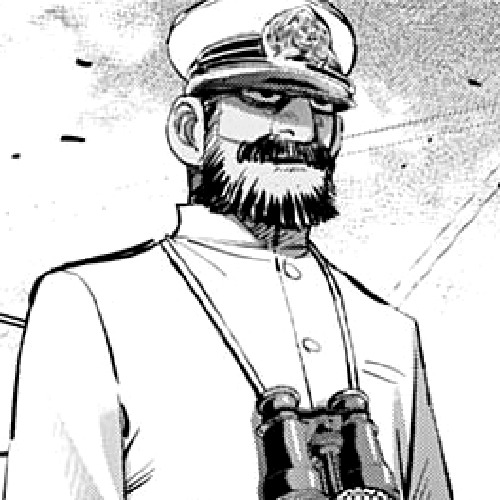
The man is likely not crying, at least not openly, but the visual suggests he is crying internally.
Tsurumi likely knows this story well, as he was in the Sino-Japanese war, though he belonged to the Army and not to the Navy (and this was a pretty well known story even for who wasn’t in the war)… though Koito can’t know this little info about the ‘kind’ stranger he’s talking with.
Anyway we see Koito senior standing on the deck of his ship and watching. We might think he’s being impassible, he’s watching still after all, although not with the binoculars, as if afraid to check the situation for himself. Also we can’t see his eyebrows hidden by his hat but I find interesting how the line below his eyes seem to resemble tears, the hat partially shadowing his face and his mouth apparently slightly opened.
Koito senior is keeping still but he’s likely a lot less impassible than he looks like.
Proof is the experience was likely traumatic to him as, when he came home, Koito noticed his father had changed, now never scolding him nor smiling to him.

Koito senior likely closed up on himself, causing his younger son, who was also trying to cope with the trauma of losing his brother as well as having people’s expectations suddenly tossed on him, feeling ignored and neglected in his time of need.
Koito is tormenting himself on his father’s behalf, trying to picture in his mind the horrific scene his father saw and of whom his classmates at the Naval Officer Academy chat, likely with a mix of horror and fascination, without a care for how Koito might feel at hearing them saying people his brother might have ended up carbonized or splattered on the deck.
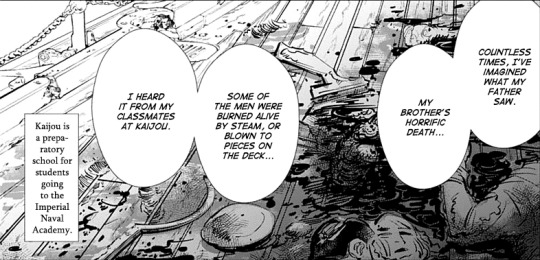
It’s rather terrible as for them it’s likely just an interesting gossip while for Koito is his personal tragedy. They don’t mean ill yet it was probably as if they were pouring salt on Koito’s emotional wounds.
It’s a situation very different from bullying yet equally painful.
It gets so bad for Koito he can’t stay on a boat for too long or he ends up thinking about his brother’s death and gets terribly seasick… which is also something that shouldn’t happen to someone who’s going to a navy school and his expected to follow his father’s footsteps.

Young Koito too was traumatized by the loss of his brother, even if he hadn’t witnessed it. Maybe for him it’s even worse as his fantasy likely comes up with even worse images.
Still it’s interesting how Koito’s eyes darken, becoming the visual clue of how ashamed he is of the fact since he can’t stay on a boat for longer than a day, he can't become a good naval officer.
It’s interesting how, according to 海壁 marmuro, in Japanese he uses a phrasing similar to when Ogata said "I had a feeling I wouldn’t be able to pull this off. I guess things just don’t work out how I want".
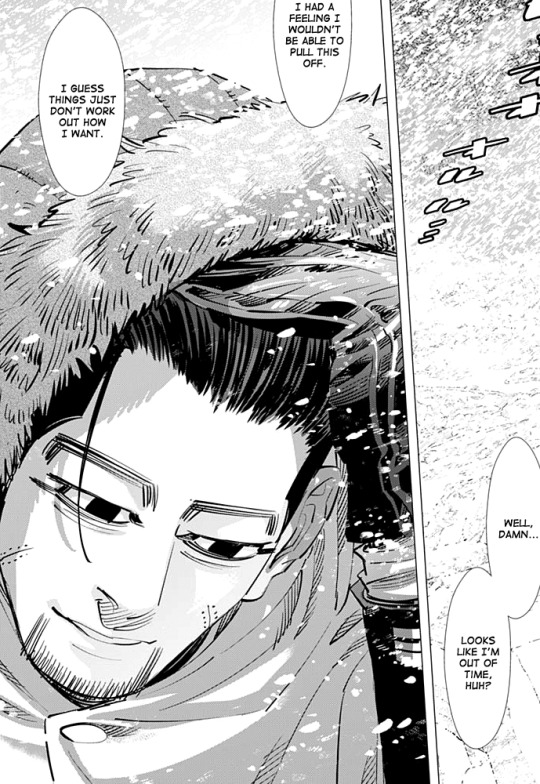
Koito and Ogata have similarities in weird, twisted ways, among which the fact they both had a brother who they believed had what they were missing.
As they leave Koito comments his brother might end up feeling lonely as they’ll have to move to Hakodate due to his father’s work… which is likely why Tsurumi got his eyes on young Koito. Since his father now would work close to him and could be an useful usable commodity, Tsurumi was studying how to proceed manipulating Koito senior through Koito junior.
Really this man is so clever and capable to plan in advantage it’s scary.
Anyway Tsurumi comments on how he thinks Koito will like the place and proceed to describe it.
Koito asks him if he knows the place and really Koito, you should study more Japanese geography as Tsurumi points out how Tsukisappu (the place that made those anpan) is in Hokkaido as well… so yes, Tsurumi knows it. Of course he does, I bet he even went to check the place.
Once they’re back where they started Tsurumi thanks Koito for the lift and says they should meet again. Koito doesn’t seem to believe it will happen but, at least he’s smiling. It’s not exactly a happy smile but a smile none less.

In a way it’s the saddest part. Tsurumi was right, talking about things likely helped Koito a lot… but this will likely end up being used against Koito in the future as this will make him an easier target for Tsurumi’s future manipulation.
In fact Tsurumi uses even Koito’s doubtful attitude in his favour by declaring if they then were to meet again by chance, Koito would have to become his friend because then their meeting would have been decided by fate.
Basically, he’s subtly sealing young Koito’s fate. I bet those words will also play a part in Koito’s future ‘friendship’ decisions.
Time skip.
We jump to two years in the future, In Hakodate. Koito is now 16 and still riding that vehicle (please notice how Noda decided to depict him in the same way as he did when Koito was 14, only a little bigger and with clothes slightly different),
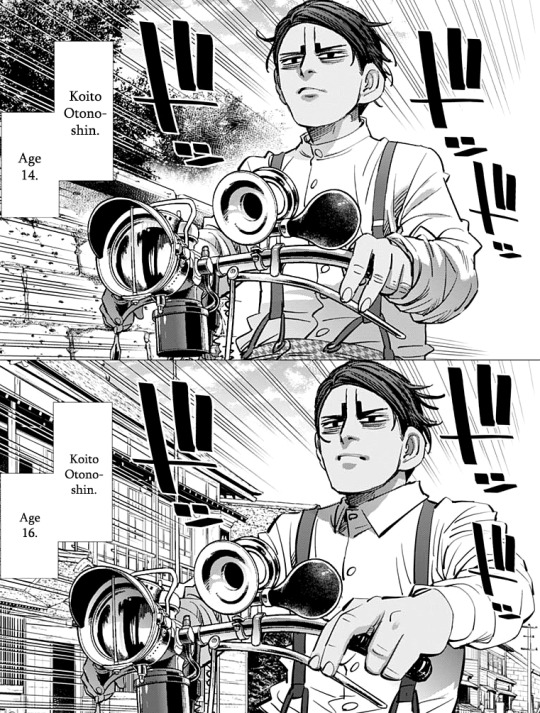
...people still commenting behind his back he’s a ‘bonbon’ or a 'pampered little brat’ if you prefer, that he’s problem child at the Naval Academy cram school and expecting him to fail at the Naval Academy entrance exams.
Long story short Koito hadn’t really got better from how he was when he met Tsurumi. Actually he might have possible gotten worse, both in the pressure he had to sustain and in character, in fact this time he complains loudly when a horse places itself in front of his vehicle, not realizing a carriage a stopped next to him.
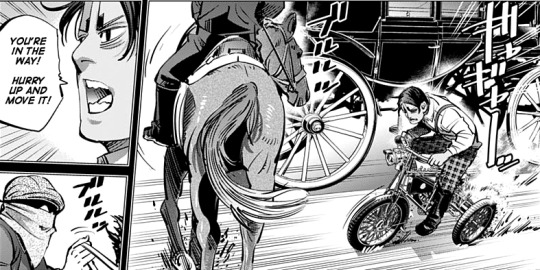
The next Koito knows is 2 men had gotten off the carriage, one had wrapped a cloth around his face and, likely, he ended up forced into the carriage and kidnapped.

Fundamentally we see only 3 kidnappers, horse guy, wearing what looks like a flat cap or a newsboy cap (not too sure about it),

the guy in the carriage, wearing a white fedora hat

and the guy who covers Koito’s face wearing a black bowler hat.

This guy might or might not be also the carriage driver.
Hard to say.
We see people wondering what had happened then, next, we see Koito’s vehicle now under the rain and next to a gate. This is clearly not the place in which Koito was kidnapped, so the vehicle was moved.
I wonder... does the fact it rained in that particular moment have some relevance in the future? After all it wasn't raining when Koito was kidnapped nor after it. It's just when they show Koito's vehicle near the gate. Ah, it's hard to say.

The narration tells us it’s 4 days later, still in Hakodate, in what is the Koito Residence (which in real life was Saigo Judo’s European-styled and themed house if you’re interested in seeing it in real life and of which @osomanga posted some photos).
And now let’s meet who’s inside Koito’s house.
The first to show up is Koito’s mom, whose name we learn is Yuki (ユキ), who shares with Koito his characteristic eyebrows (and who’s really pale in case you had forgotten what was said in the past chapter).
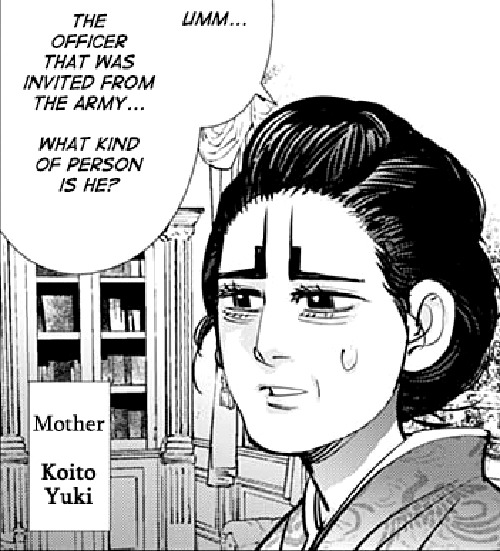
Yes, her name is in katakana. I’ve researched a bit on the topic and it turned out in Meiji it was pretty popular to call girls with names all written in katakana because that, along with the kanji alphabet, what the alphabet for official documents.
The trick though is that katakana was used for girls because poor people who didn’t know kanji would still hire someone to tell them good kanji to use for their male sons but won’t judge girls names worth the same care so they would just get a name in katakana.
But… well, this was for people who didn’t know kanji. So… does this mean Koito’s mom comes from a commoner family? I would have expected her to be upper class and therefore come from a family who would know kanji (after all Umeko, O-Gin, Chiyoko and even Asirpa have names written in kanji… the only exception being Fumie, Tanigaki’s sister who, however wasn’t rich and Tome of whom we know absolutely nothing and who could have been foreigner or Ainu or imaginary for all we know…) so… no idea.
Anyway Koito’s mom is clearly nervous and worried as she asks info aboutthe Army officer who was asked to take part to her son’s research.
The one who answers to her fears is the naval captain Nakayama (中山海軍大尉 ‘Nakayama Kaigundaii’).

To give you a general idea of how high the guy is ranked the navy goes (from the lowest officer rank to the highest):
OF-1 海軍少尉 Kaigun-shōi (Ensign) [Koito Heinojou] & 海軍中尉 Kaigun-chūi (Sub-lieutenant/Lieutenant junior grade)
OF-2 海軍大尉 Kaigun-daii (Lieutenant) [Nakayama]
OF-3 海軍少佐 Kaigun-shōsa (Lieutenant-commander)
OF-4 海軍中佐 Kaigun-chūsa (Commander)
OF-5 海軍大佐 Kaigun-daisa (Captain)
OF-7 海軍少将 Kaigun-shōshō (Rear-admiral) [Koito Heiji]
OF-8 海軍中将 Kaigun-chūjō (Vice-admiral)
OF-9 海軍大将 Kaigun-taishō (Admiral)
OF-10 元帥、海軍大将 Gensui-kaigun-taishō (Grand admiral)
大元帥 Dai-gensui (Lord high admiral) = The emperor of Japan
Nakayama is an OF-2 大尉 daii (Lieutenant), Koito’s brother Koito Heinojou was an OF-1 少尉 shōi (Ensign). Koito Heiji is an OF-7 少将 shōshō (Rear-admiral) in Vol 13, though in this chapter they referred to him as OF-4 中佐 chūsa (Commander)… but I think they aren’t really talking about his rank, they’re probably merely referring to him as the commander of the base. Otherwise it would be impressive if in 5 years he managed to jump of 3 ranks.
In short, Nakayama is technically slightly higher than Tsurumi (who’s a OF-1 中尉 Chūi (First Lieutenant)).
I wonder if Nakayama serves under Koito senior or he’s under some other official.
Anyway, back to the story, Nakayama hurries to answer to Koito’s mom, explaining the guy handling things is a sharp guy from Tsukisappu's intelligence division really proficient in Russian, so they had to entrust the whole matter to him.
Wanna start place your bet on who this guy is?
Do we know someone who was recently mentioned to be stationed in Tsukisappu, who works as an intelligence officer and who’s proficient in Russian?
Koito senior is seated down and, if you ask me, he also looks pretty down.
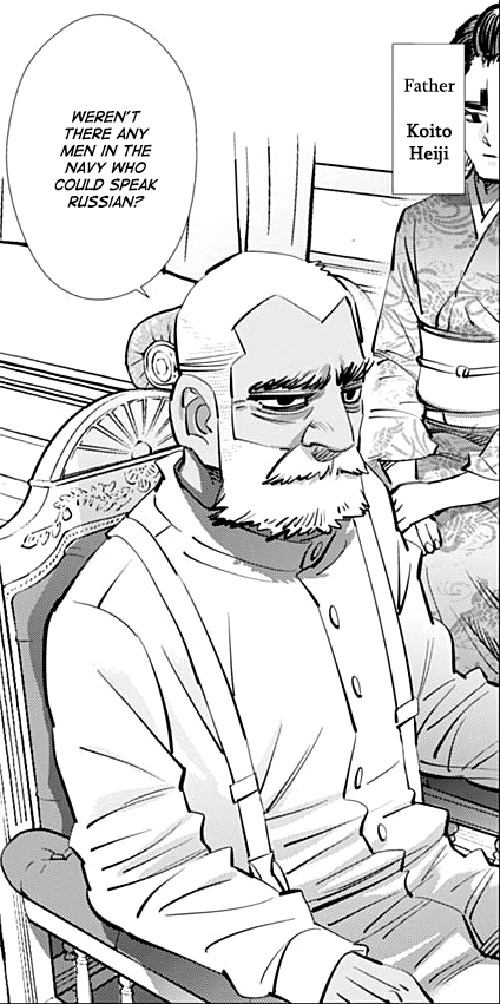
The bags under his eyes are shadowed to emphasize on them. He might seem calm and collected but he probably didn’t have 4 nice days. Koito senior was traumatized by his firstborn’s death and now he has to deal with his other son being kidnapped.
He however manages to remain an navy man who clearly doesn’t trust army men and therefore asks if they couldn’t have found a navy person who spoke Russian and could take care of the matter.
For who doesn’t know it there was a strong rivalry between the army and the navy and very poor relations. No wonder Koito’s dad didn’t want an army man to be involved.
As if on clue, no scratch it, on clue, Tsurumi appears introducing himself and surprising Nakayama and Koito’s mom. Koito’s dad instead doesn’t visually show signs of surprise.

His son described Koito Heiji as a man who didn’t scold nor smile anymore after his brother’s death. This guy is suppressing all his emotions, even a natural surprise at having a complete stranger appear all of sudden in your house.
Tsurumi, who has clearly come in unannounced explain he got in from the back entrance (so he could look professional, serious, dedicate and clever, surprise/impress everyone, show he’s actually in control of the situation and also eavesdrop the discussion without being noticed… I love how clever this guy is).
Although polite Tsurumi starts ordering people around likely taking advantage of their surprise. Mind you, his orders make sense but they would probably be met with more resistance considering the distrust there was between army and navy if he hadn’t surprised them and filled them with a sense of urgency and secrecy as well as the impression he’s in control of the situation (remember? He’s the lowest in rank there…).
In fact he politely orders to close all the curtain, claiming they’ve to do it or people will discover their strategy to recover the Koitos’ son.
It’s subtle but we can see Koito’s mom standing up at this.

She likely got up and went to do as Tsurumi says because he also filled her with a mix of hope and fear. Tsurumi shows up like a savior who has a strategy to save her baby but if they don’t obey him all will be lost.
Koito senior doesn’t react, just stares at Tsurumi. Either he’s not impressed/not buying it or he’s still trapped into his shell.
And now we’re shown a better picture of the place where Koito’s vehicle had been left…

along with explanations from Tsurumi on where it exactly is and it turns out it’s inside the Russian embassy’s closed gates, which, according to Nakayama is CONVENIENTLY deserted in summertime although, since it’s technically a Russian territory, they CONVENIENTLY couldn’t get in.
Now… I’m not a Russian kidnapper but if I were, since the purpose would be to get Koito senior’s cooperation and not to alert Japan government I’m trying to blackmail him to force him into cooperation, I wouldn’t put around a GIANT sign saying RUSSIA KIDNAPPED KOITO SENIOR’S SON for everyone to see.
Maybe it’s just me but I value discretion in this sort of things so I would contact Koito senior secretly and make my demands BEFORE he could get to warn EVERYONE, especially the Army who’s not under duty to obey his requests, about how I’m trying to blackmail him.
You know, so the Army wouldn’t keep an eye on Koito senior or demand for him to be removed from his duty as soon as he attempts to obey my requests. Or risk a diplomatic scandal. But well, okay, it’s just me.
I don’t really have a degree in kidnapping so I might be wrong.
In fact some guys instead might want for everyone to know that hey, RUSSIA DID IT, IT’S RUSSIA, IT’S ABSOLUTELY NOT ME and that the ARMY NEEDS TO BE INVOLVED BECAUSE A CERTAIN RUSSIAN SPEAKING OFFICER WORKS THERE AND HE NEEDS TO BE INVOLVED SO HE CAN SHOW OFF AND CHARM KOITO FATHER & SON so I guess they might not care about privacy and secrecy.
At each his own.
Tsurumi keeps on showing he’s perfectly in control by smoothly saying of course there wouldn’t be someone in the consulate because of course ‘Otonoshin-kun’ likely isn't in there (that’s how Tsurumi refers to Koito in the Japanese version).
Note that Tsurumi is using Koito’s name not for an excess of familiarity but because it’s a pretty common thing to do when there’s more than one person with the same surname around, so as to avoid confusion. And of course he probably sounds more caring and subtly reminding them of how Koito is young (he used ‘–kun’, not ‘–san’).
Koito’s mom is worried they’re after money but Tsurumi OF COURSE knows that’s not the case though he tactfully says it can’t be because there's plenty of rich kids in this town… which ensures her kid wouldn’t be targeted why? I mean, more kids among whom to choose don’t mean some are save and some aren’t, they all have the same probabilities of being kidnapped, if it’s about money.
Then Tsurumi subtly gives a painful jab at Koito senior by pointing out how if Russia is participating in a kidnapping the matter would be pretty serious.

Tsurumi doesn’t explain why, we’ll get why in a few minute through young Koito but, to better give you a view on the situation and on how it’s extremely clever to show Tsurumi looking up and standing tall over Koito Heiji, whose gaze is downcast the truth is that what Tsurumi is implying is that Russia is actually targeting not Koito Otonoshin but his father, Koito Heiji.
Young Koito was kidnapped due to his father, so as to allow Russia to blackmail him. It’s a dirty jab and something Koito Heiji has likely already realized. This man was likely incorruptible and without any dark secret but Tsurumi still has found a way to stand above him and try to control him.
He placed on him the burden of being responsible for his own son’s kidnapping and is trying to take advantage of the man’s trauma when he lost his first son by threatening to take away from him his second son to then return it to him.
Tsurumi is an amazing chessmaster, really. I can only bow to him.
But, as I’ve said, all this won’t be told to us now. We’ll switch to where young Koito is held.

He’s kept tied to a pole and he has heavy bags under his eyes but he seems fine, unharmed. A man orders him to drink in Russian and hands him some water.
He’s the white fedora kidnapper, the one who was in the carriage. Though he’s ordering Koito around it seems his Russian isn’t that rude (thanks @fg083!) but it can be a matter of translation from Russian to Japanese so I don’t know. The man’s face is completely hidden.
Koito realizes the guy is talking to him in Russian and asks him if he understands Japanese to which he’s merely told to shut up, always in Russian.
Koito, always the obedient kid, doesn’t (well, actually he doesn't understand Russian but he could have figured out the meaning anyway).
Well, truth is I pity him here because his situation is pretty grim and he probably needs to voice what he has inside.
Koito says that, regardless of how he may not look it, he is the son of a man in the navy…
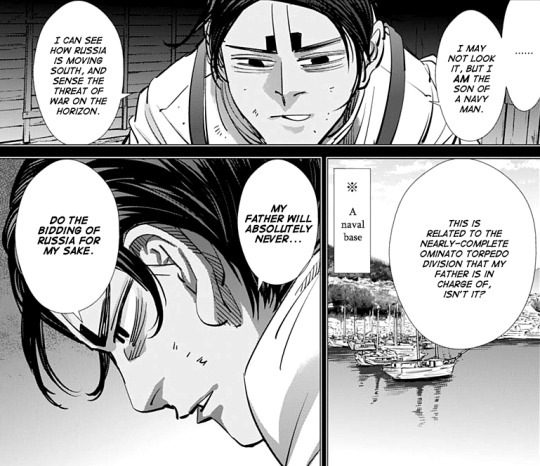
...and his start is already sad because Koito clearly knows those guys know who his father is. What he’s trying to say isn’t to inform his kidnappers he’s the son of a sailor but that he’s the WORTHY son of a sailor and therefore understood his own situation. Therefore he’s not just a naïve and ignorant ‘bonbon’.
Which is Koito’s situation?
That, according to Koito, Russia kidnapped him because his father is supervising the soon-to-be-finished “Ominato Torpedo Division”. Koito though is sure his father definitely won’t bow to Russia’s requests for his sake.
It’s undoubtedly a sad and terrible situation.
We’d like to think our parents would sacrifice everything for the sake of keeping us safe but Koito is sure his father wouldn’t do this for him… and not only it’ll turn out Koito is right but, as sad as it is, Koito’s father would be right in doing so.
But let’s have Tsurumi explain us why as we switch to him.
Tsurumi tells us if the Russian fleet in Vladivostok (remember? The Russian city in which Tsurumi worked as a spy under the name of Hasegawa) were to go through the Tsugaru Strait and make it to the Pacific Ocean, the "Ominato Torpedo Division" and "Fort Hakodate" would be thorns in their sides.

From a map we can see that basically the two things Tsurumi mentioned control the opposite points of the street. In short they’re the Japanese system to stop the Russian advance in that direction.
The Russian fleet would have then to take the longest road and try to pass through the street in between Karafuto and Hokkaido or the even longer one that required it to pass in between the Korean empire and Fukuoka… Korean empire on which Japan was already exerting its influence, which will later will become more official by forcing Korea to sign a series of treaties that will turn it into a Japanese protectorate, until it’ll get annexed to Japan in 1910.
Not good choices.
As if this wasn’t enough Nakayama tells us at the moment torpedo boats scheduled for deployment to Ōminato are in Port Hakodate as well. Tsurumi thanks for the info, though I bet he knew about it already and this is just a confirmation.
Anyway he does on and claims that if the kidnappers are Russian, what they want is to destroy those in order to render Japan temporarily powerless... which would mean Russia could then easily attack/invade Japan.
Nakayama though has a clever observation which is that it’s strange that no kind of demand has come from the kidnappers…

too bad Tsurumi will use it to his advantage to bring them all (well, except Koito’s mom) ILLEGALLY in the Russian consulate.
Tsurumi’s eyes darken as he sees Koito’s vehicle.

As this doesn’t mean always the same thing but it varies from character to character, it’s hard to guess what’s going on in his mind.
I can’t really remember when it happened in the past with Tsurumi. His face went completely dark when he saw Wilk and Kiro’s wanted posters…

so is he thinking his plan is going well? Though this time his face isn’t completely dark… does he feels a tiny pang of regret for having involved young Koito? For forcing another father to fear to lose his child as he lost Olga? Or for him is fair retribution as he lost Olga due to his work and to someone likely tattling him out and so Koito senior too should try this even though eh already lost one child?
Hard to say.
Anyway prior to watching Koito’s vehicle he says something might happen from here on out and, of course, something happens. The phone starts ringing as if it was expecting them… because yes, it was.
Koito’s dad would want to go to answer because he thinks it might be from the kidnappers.

From the way he says it, he betrays he’s worried for Koito and would want to do something for him. Tsurumi though, although agreeing with him, tells him to wait because the timing of their call is too good and therefore the Russian consulate is likely under surveillance by the kidnappers so they should pretend they didn’t hear the call and go back.
Notice Tsurumi’s mastery. Koito’s dad wanted to rush to answer but he manages to keep control of the situation and stop him with his logic and knowledge. He’s a rank 7 ordered around by a rank 1. Tsurumi being there when the phonecall is being made makes him clearly above suspicions. It can’t be Tsurumi calling them as Tsurumi is with them.
Tsurumi claiming one should be always capable to read his opponent movements and keep himself two step ahead makes him look extremely clever and capable, opposed to Koito’s dad who, for a moment lost it and wanted to rush in.

The addition that if they were to mess up the kidnappers would ‘checkmate’ them, feeds the man’s fear his son could die and forces him into compliance even when he doesn’t want to. Asking to Koito’s father to please endure it by calling him Commander Koito-dono is also Tsurumi forcing him into obedience by reminding him or his rank. Koito senior isn’t just a worried father, he’s a rear admiral. He can’t rush into things.
Ah, Tsurumi is clever, I can’t help but really bow to him.
So back to Koito senior house we go after Tsurumi has better worked up an emotional and intellectual control over the guy.
So now Tsurumi can show off how competent he is by trying to figure out where the kidnappers are.
…there are 320 telephones in Hakodate… considering the range one can see the Russian consulate from a telescope and removing public places…. Hey, awesome, there can be only over 50 places in which the kidnappers can hide.
His underlings are scouting them but they can’t really enter in as they’ve to be subtle or everything will be lost but hey, once they’re ready they’ll go to the Russian consulate again and if they phone they’ll have ‘Otonoshin-kun’ come to the phone and confirm he's alive then hang up and get the phone number from the phone switchboard operator and from it find out the hideout.
In short although normally it would be really, really hard to find ‘Otonoshin-kun’ hey I came up with this perfect plan that will make it a piece of cake. Aren’t I awesome? Yes, Tsurumi, you are.
I wouldn’t entrust to you not even my worst enemy but you’re awesome. I bow to you.
Oh, not for what your plan to ‘save’ ‘Otonoshin-kun’ but for how you’re manipulating this people into thinking you’re the best thing after sliced bread. No, never mind, you’re the best thing PRIOR AND AFTER sliced bread as sliced breat started being sold in 1928, while you were awesomely manipulating people from 1891. Possibly prior to it. But well, we’ve no info on what you did prior to tricking Wilk, Kiro and Sofia. We’ll wait for you to enlighten us.
Koito’s mom is touched and start to cry so Tsurumi puts up his best caring act assuring the distraught mother he’ll do all he can so she has to make sure not to throw away all your hope.

Yeah, or all of Tsurumi’s efforts into painting himself as your lord and savior will go for naught.
Image of Koito’s dad’s face. The poor guy is sad, he still has dark bags under his eyes… and likely, even if he can’t cry like his wife he’ll want to and Tsurumi’s words are actually targeted to ensnare him more than his wife.
And so back to the consulate we go, with Tsurumi, Koito senior and Nakayama.
They… have broken in.

Not just in Russian territory as the consulate is in Russian territory but also inside the building. If Koito senior never did anything wrong before, now he risks causing a diplomatic scandal if this turns out. It’s all blackmail material for Tsurumi… though I think Koito senior would shoot himself in the head prior to let himself be forced into submission.
Anyway Nakayama claims he found a phone but points out they could have just phoned to Koito senior’s house since he too has a phone.
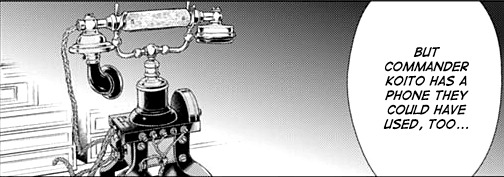
Good observation, Nakayama.
Tsurumi claims since the Russian consulate is the highest up on Mt. Hakodate's slope it's easier to watch the whole town from there…. so the kidnappers would choose that phone why? Because they wanted to show Koito senior a place? Is this the theory now?
Bah, I’m more concerned in why Tsurumi would want the kidnappers to phone there. Is he really planning to use the breaking into the embassy against Koito senior? I’m really not sure it’ll work…
Anyway we’re in the past so making phonecalls is tied to the time in which the phone operator office works. As it closed at 19:00 a phonecall can come only after 6:00. Meanwhile they’ll have to light a lamp and warn the kidnappers (and possibly Hakodate police) they had break into the Russian embassy illegally… because the kidnappers were supervising the embassy the past time and made a perfectly timed phonecall but they clearly wouldn’t do it now. No, respectable kidnappers go to bed when it’s late in the night.
Comes to wonder how they can notice the light if they’re sleeping but well, let’s let it slide.
So let’s turn on the lights of an embassy in which no one should be and chat a little.
The chat isn’t a pleasant one.
Koito senior states that if the perpetrators’ demands are to neutralize the Ominato Torpedo Division and Fort Hakodate and they were to comply the Russian navy could immediately start a war and come to easily invade Japan.
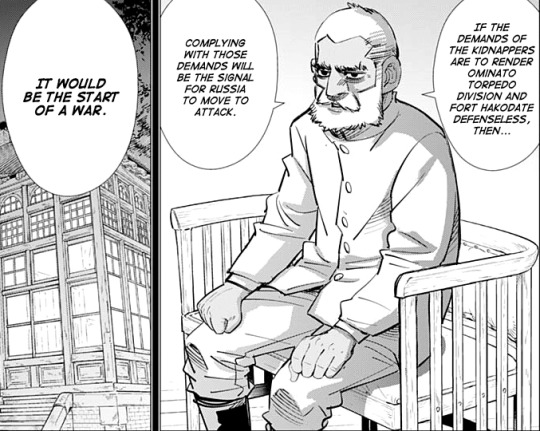
Now, we’ve to remember Koito’s father isn’t just Koito’s dad he’s also a REAR ADMIRAL. He has been in a war. He has been responsible for the lives lost in a war, included the one of his elder son. It’s his duty to protect Japan. Faced with such a situation he can’t help but asking himself how many hundreds of thousands of… no, how many millions of Japanese citizens would die due to the war he had caused for the sake of protecting his son.
A war of invasion is a massacre. If Russia were to invade Japan it wouldn’t be just the Japanese soldiers dying but also the civilians. And we also have to remember this massacre could end up involving his son and his wife as well. Never mentioning he can’t just say in front of another navy officer and an army officer he would gladly sell off Japan for his son’s sake.
If he were to do so Tsurumi could very well report him and have him arrested for betrayal. The whole Koito family would be ruined, Koito included.
We see Nakayama is sweating.

I think Nakayama is probably working below Koito senior and would want to help him but he likely understands the gravity of the situation.
Tsurumi isn’t sweating at all. He knows they’re perfectly safe because he’s perfectly in control of the situation ( and there’s no Russia behind this).
Still the face off is interesting. Tsurumi never had the chance to chose to betray his country to save Olga. I wonder what he thinks when, faced with all this, Koito senior claims he has no choice as the best option is (not bow to the kidnappers demands) and to let Otonoshin, HIS OWN SON, die.
Koito senior’s face as he speaks is shadowed but we can see tiny lines in the white of his eyes. I think the idea is they’re meant to signal to us the guy has red eyes, either from lack of sleep or from the effort to control himself and not to cry.

Koito senior is talking as a rear admiral, responsible for the life of everyone in Japan. He doesn’t curse Japan for the situation in which he was put, for first taking away from him one of his sons in a war and now having his other son being kidnapped by Russian. Koito senior is still thinking at the biggest picture, the well being of his country.
His son, his own feelings as father are necessary sacrifices to ensure the survival of milions of other people who trust him to protect them.
Tsurumi never had to face such chance. As he was doing his job he had his own child gruesomely murdered, a bullet going through her face, murdering her and disfiguring her.

A calculation error, a mistake on his part as he didn’t expect Fina to worry for him and come back for him and getting caught in the crossfire.
Tsurumi had to hold his own child who probably still had to learn to call him dad against his chest and watch her once lovely face being ruined by an ugly wound from which blood poured and think over and over he was to blame, that it was his mistake. His mistake?
Or it was all due to Japan, who used him for such job? If his family had remained rich… would he have ended up in Vladivostok as a spy? Would he still have to face losing such a young and beloved child as well as a person who loved him? Because even if he likely married Fina only to have a cover, in the end they clearly ended up loving each other and, more importantly, loving their own child.
Tsurumi plays father for all the men in the 7th, ultimately sacrificing them on the altar of his own ambitions, men of the 7th who all had troubles with their parents and needed them, from Ogata who was abandoned to Tsukishima who was abused, to Koito who felt neglected, to Tanigaki who disagreed with him and now that he has discovered his father was right feels too ashamed to face him.
Tsurumi, the father who lost his child, opposes to Asirpa, who plays the mother and WHO’S ACTUALLY A CHILD who never had a child of her own and lost her own mother (and father). The fake father who manipulates men for his own goals versus the fake mother who takes care of them and would want to heal them.
The ending will likely be a battle between ‘fake parents’… though if Asirpa will manage to kick Tsurumi’s ass Nihei will be proved right again. Women sure can be scary.
Anyway for now this flashback is turning into a flashback that’s not anymore about young Koito’s traumatic loss and experience but about two fathers facing each other. Two fathers who should have both fought for Japan… and whose loyalty was tested by taking away their sons.
Tsurumi ultimately became a rebellious officer who’s trying to steal Hokkaido from Japan while Koito senior, so far, despite his loss, is still loyal to Japan and willing to lose another son.
Honestly I’m curious to see how it will develop.
Young Koito will be saved, that’s for sure, but what about Koito senior? Will he become completely Tsurumi’s pawn as Tsurumi will have the means to blackmail him? Or will he just end up becoming his ally merely because he was tricked by him? Will Koito senior loyalty to Japan crash? And how Koito senior’s presence will play out in the future?
We’ll see.
… but the good part of this flashback is it might also explain why Koito senior accepted to support Tsurumi when he attacked Abashiri… because Koito senior would know there was no grasshopper attack. They were cannoning Abashiri prison and murdering everyone who was in attempting to get Nopperabou. And after he drove Sugimoto and the others away.
Is his true purpose to get Koito THE HELL AWAY from Tsurumi under the guise to turn him into a good officer? We’ll see… but I think in his own way he cares for his son…. Even though he’s a duty devoted man who doesn’t show openly his emotions.
After all he couldn’t think Nopperabou had a daughter only to use her.


Back to the kidnappers’ hideout the white fedora guy offers Koito something to eat. Koito looks fatigued, even though he still doesn’t look mistreated. Clearly being held tied for so long doesn’t do wonders for the health.
We could visually recognize the food the kidnapper offers to Koito but Koito only does after taking a bite.

It’s the ‘Tsukisappu Anpan’ Tsurumi offered him when they first met.

Sei Kobiyama let us know the Tsukisappu Anpan was only sold in shops of the Army … so the kidnappers couldn’t have bought it if they weren’t in the Army.
That or someone from the army sold it to them as a signal for young Koito that help was coming his way (assuming he were to remember the taste and look of a sweet he ate 2 years ago).
Personally I’m sure the Tsukisappu Anpan is a signal for Koito, no way Tsurumi offered them to young Koito and then, by coincidence, they were offered to him again by his kidnappers.
The hardest part though is to pinpoint who the kidnappers are.
@chibivesicle , I and the other guys at discord had been considering various options but it’s pretty hard to say something for sure.
We know they are surely 3, maybe 4 (one might be driving the carriage and never be shown). One of them talks Russian, we never heard the others speak. Is it a sign they can't talk Russian? A coincidence?
Hard to say.
After Koito is kidnapped we only see the white fedora guy. For all we know the others could have left for other jobs.
Very, very likely they aren’t Russians as I like to hope Russia would come up with a better plan… though yes, if Tsurumi managed to put a mole into the ‘Russian kidnapping squad’ maybe poor Russians too are being manipulated by Tsurumi (is there someone in this manga who has never been manipulated by Tsurumi?) into kidnapping Koito and following Tsurumi’s plan.
Another option would be Tsurumi hired some goons… and had one of his Russian talking men with them to keep an eye on them. As they all keep their faces covered the goons might not know who hired them and who among them is Tsurumi’s man. Advantages of hiring goons would be Tsurumi would have someone unrelated to him to arrest and possibly shoot to show off how good he is at saving people. Also if they screw up and Koito manages to see their faces there’s no future risk for Koito to recognize them among Tsurumi’s men. On the other side it would mean to trust them to follow a plan without being there to supervise them. Risky, I would want at least a man I can trust between them.
And, of course, it can be all the men involved are actually men of the 7th. As all this happened in 1902 and they had to be trusted I’ll say we can skip the private first class as they’re obviously new recruits who weren't working yet for Tsurumi in 1902.
Superior privates like Ogata or Usami (who’s older than Ogata according to Noda and therefore can be in the army by slightly longer time) might have been around but I don’t know if Tsurumi would trust them as back then they would be the new guys. This is a task I would entrust to my most trusted henchmen… though it’s true we only see the white fedora man interacting with Koito. The others might not have much to do.
I guess to figure out their identity it would be relevant to know if Tsurumi plans to shoot at them during an heroic rescue action or not.
We know there are few men who can speak Russian in the whole army… but well, we hear only 1 of the kidnappers using Russian. The others might not know it. So the Russian speaking one as far as we know is only white fedora guy.
Among the men from the 7th speaking Russian instead we know only Tsukishima and Ogata (well, Kiro too but back then he wasn’t in the 7th). The story seems to want us to focus on Ogata but, unless Ogata had been working with Tsurumi by a long time, I don’t know if Tsurumi would trust him with such a delicate task.
Among the other old timer, though we don’t know if they can speak Russian, there are Tamai and Kikuta. It would make sense if Tamai were another who had done dirty work for Tsurumi and now wanted to rebel against him. Kikuta… I’m not sure. He seems to be a man who serves the most profitable master but I don’t know if he’ll go and take part to the kidnapping of a real admiral’s son. Looks risky.
Honestly I’m not even sure Tsurumi would use him as Kikuta is clever and could use this against Tsurumi.
Tsukishima could be a good choice as he’s really loyal to Tsurumi but… is he morally and emotioanlly up to handle a kidnapping plan? Of a young boy? Though this could explain why he’s so tolerant with Koito, he merely feels guilty.
Of course there’s also the guy who appeared in the Tuskishima flashback and who’s still unnamed...
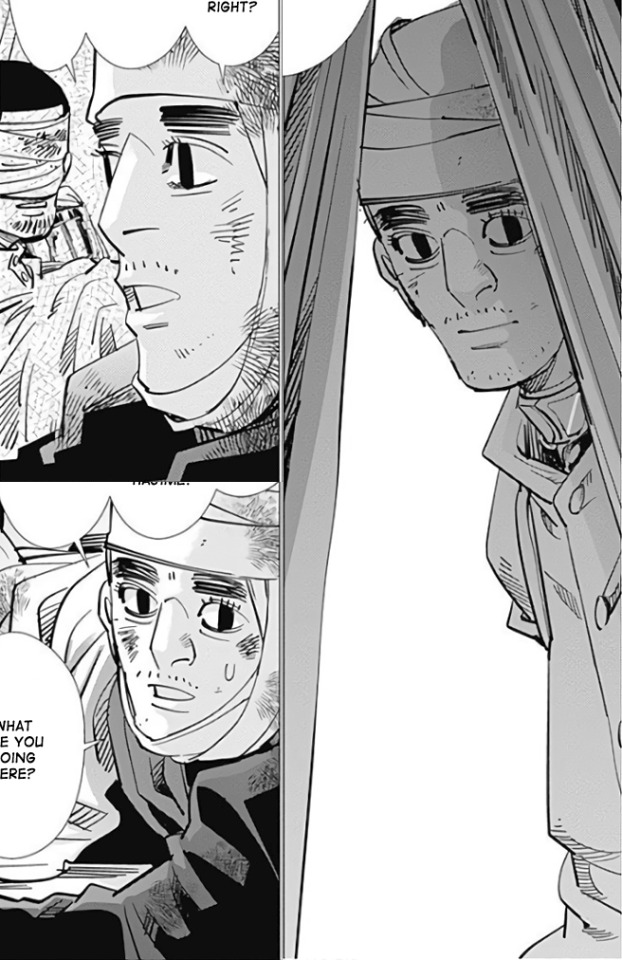
...and Tsurumi’s coach driver, who accompanied him to his secret meeting with Ogata after Hanazawa was killed in the Ogata's flashback.

Whose guys might be Tsurumi’s men in this job.
Hell, Tsurumi himself might have been the guy on the horse for all we know, as he was shown riding.

Back to Ogata though, it would make things interesting if it was him because it would explain why he insulted Koito in Russian. He would want Koito to remember this specific experience. But it’s really hard to say.
Tsukishima’s Russian never caused Koito to remember that experience. Of course it’s possible Koito believes Tsukishima worked as a mole for Tsurumi among his kidnappers and therefore knows he was involved but has no idea how much.
Also, in the same way as it wasn’t the anpan’s shape what caused Koito to remember but the situation, it can’t be it’s not the Russian that’s causing Koito to remember but the situation, being a hostage of someone who’s speaking Russian.
LOL, it would be really fun if it were to turn out it was the doctor who was involved in the kidnapping but since he showed no reaction to seeing Koito and instead he was interested in Ogata honestly I don’t really think so.
Anyway that was all for this chapter.
#Golden Kamuy#Koito Otonoshin#Koito Heiji#Tsurumi Tokushirou#Koito Yuki#Koito Heinojou#Nakayama#Golden Kamuy Ramblings and Theories
16 notes
·
View notes
Text
Events 5.4
1256 – The Augustinian monastic order is constituted at the Lecceto Monastery when Pope Alexander IV issues a papal bull Licet ecclesiae catholicae.
1415 – Religious reformers John Wycliffe and Jan Hus are condemned as heretics at the Council of Constance.
1436 – Assassination of the Swedish rebel (later national hero) Engelbrekt Engelbrektsson
1471 – Wars of the Roses: The Battle of Tewkesbury: Edward IV defeats a Lancastrian Army and kills Edward of Westminster, Prince of Wales.
1493 – Pope Alexander VI divides the New World between Spain and Portugal along the Line of Demarcation.
1626 – Dutch explorer Peter Minuit arrives in New Netherland (present day Manhattan Island) aboard the See Meeuw.
1686 – The Municipality of Ilagan is founded in the Philippines.
1776 – Rhode Island becomes the first American colony to renounce allegiance to King George III.
1799 – Fourth Anglo-Mysore War: The Battle of Seringapatam: The siege of Seringapatam ends when the city is invaded and Tipu Sultan killed by the besieging British army, under the command of General George Harris.
1814 – Emperor Napoleon arrives at Portoferraio on the island of Elba to begin his exile.
1814 – King Ferdinand VII abolishes the Spanish Constitution of 1812, returning Spain to absolutism.
1836 – Formation of Ancient Order of Hibernians
1859 – The Cornwall Railway opens across the Royal Albert Bridge linking Devon and Cornwall in England.
1869 – The Naval Battle of Hakodate is fought in Japan.
1871 – The National Association, the first professional baseball league, opens its first season in Fort Wayne, Indiana.
1886 – Haymarket affair: A bomb is thrown at policemen trying to break up a labor rally in Chicago, United States, killing eight and wounding 60. The police fire into the crowd.
1904 – The United States begins construction of the Panama Canal.
1910 – The Royal Canadian Navy is created.
1912 – Italy occupies the Greek island of Rhodes.
1919 – May Fourth Movement: Student demonstrations take place in Tiananmen Square in Beijing, China, protesting the Treaty of Versailles, which transferred Chinese territory to Japan.
1926 – The United Kingdom general strike begins.
1927 – The Academy of Motion Picture Arts and Sciences is incorporated.
1932 – In Atlanta, mobster Al Capone begins serving an eleven-year prison sentence for tax evasion.
1942 – World War II: The Battle of the Coral Sea begins with an attack by aircraft from the United States aircraft carrier USS Yorktown on Japanese naval forces at Tulagi Island in the Solomon Islands. The Japanese forces had invaded Tulagi the day before.
1945 – World War II: Neuengamme concentration camp near Hamburg is liberated by the British Army.
1945 – World War II: The German surrender at Lüneburg Heath is signed, coming into effect the following day. It encompasses all Wehrmacht units in the Netherlands, Denmark and northwest Germany.
1946 – In San Francisco Bay, U.S. Marines from the nearby Treasure Island Naval Base stop a two-day riot at Alcatraz Federal Penitentiary. Five people are killed in the riot.
1949 – The entire Torino football team (except for two players who did not take the trip: Sauro Tomà, due to an injury and Renato Gandolfi, because of coach request) is killed in a plane crash.
1953 – Ernest Hemingway wins the Pulitzer Prize for The Old Man and the Sea.
1959 – The 1st Annual Grammy Awards are held.
1961 – American civil rights movement: The "Freedom Riders" begin a bus trip through the South.
1961 – Malcolm Ross and Victor Prather attain a new altitude record for manned balloon flight ascending in the Strato-Lab V open gondola to 113,740 feet (34.67 km).
1970 – Vietnam War: Kent State shootings: The Ohio National Guard, sent to Kent State University after disturbances in the city of Kent the weekend before, opens fire killing four unarmed students and wounding nine others. The students were protesting the Cambodian Campaign of the United States and South Vietnam.
1972 – The Don't Make A Wave Committee, a fledgling environmental organization founded in Canada in 1971, officially changes its name to "Greenpeace Foundation".
1973 – The 108-story Sears Tower in Chicago is topped out at 1,451 feet as the world's tallest building.
1978 – The South African Defence Force attacks a SWAPO base at Cassinga in southern Angola, killing about 600 people.
1979 – Margaret Thatcher becomes the first female Prime Minister of the United Kingdom.
1982 – Twenty sailors are killed when the British Type 42 destroyer HMS Sheffield is hit by an Argentinian Exocet missile during the Falklands War.
1988 – The PEPCON disaster rocks Henderson, Nevada, as tons of Space Shuttle fuel detonate during a fire.
1989 – Iran–Contra affair: Former White House aide Oliver North is convicted of three crimes and acquitted of nine other charges; the convictions are later overturned on appeal.
1990 – Latvia declares independence from the Soviet Union.
1994 – Israeli Prime Minister Yitzhak Rabin and PLO leader Yasser Arafat sign a peace accord, granting self-rule in the Gaza Strip and Jericho.
1998 – A federal judge in Sacramento, California, gives "Unabomber" Theodore Kaczynski four life sentences plus 30 years after Kaczynski accepts a plea agreement sparing him from the death penalty.
2000 – Ken Livingstone becomes the first Mayor of London (an office separate from that of the Lord Mayor of London).
2007 – Greensburg, Kansas is almost completely destroyed by a 1.7-mile wide EF5 tornado. It was the first-ever tornado to be rated as such with the new Enhanced Fujita scale.
2014 – Three people are killed and 62 injured in a pair of bombings on buses in Nairobi, Kenya.
0 notes
Text
Events 5.4
1256 – The Augustinian monastic order is constituted at the Lecceto Monastery when Pope Alexander IV issues a papal bull Licet ecclesiae catholicae.
1415 – Religious reformers John Wycliffe and Jan Hus are condemned as heretics at the Council of Constance.
1436 – Assassination of the Swedish rebel (later national hero) Engelbrekt Engelbrektsson
1471 – Wars of the Roses: The Battle of Tewkesbury: Edward IV defeats a Lancastrian Army and kills Edward of Westminster, Prince of Wales.
1493 – Pope Alexander VI divides the New World between Spain and Portugal along the Line of Demarcation.
1626 – Dutch explorer Peter Minuit arrives in New Netherland (present day Manhattan Island) aboard the See Meeuw.
1686 – The Municipality of Ilagan is founded in the Philippines.
1776 – Rhode Island becomes the first American colony to renounce allegiance to King George III.
1799 – Fourth Anglo-Mysore War: The Battle of Seringapatam: The siege of Seringapatam ends when the city is invaded and Tipu Sultan killed by the besieging British army, under the command of General George Harris.
1814 – Emperor Napoleon arrives at Portoferraio on the island of Elba to begin his exile.
1814 – King Ferdinand VII abolishes the Spanish Constitution of 1812, returning Spain to absolutism.
1836 – Formation of Ancient Order of Hibernians
1859 – The Cornwall Railway opens across the Royal Albert Bridge linking Devon and Cornwall in England.
1869 – The Naval Battle of Hakodate is fought in Japan.
1871 – The National Association, the first professional baseball league, opens its first season in Fort Wayne, Indiana.
1886 – Haymarket affair: A bomb is thrown at policemen trying to break up a labor rally in Chicago, United States, killing eight and wounding 60. The police fire into the crowd.
1904 – The United States begins construction of the Panama Canal.
1910 – The Royal Canadian Navy is created.
1912 – Italy occupies the Greek island of Rhodes.
1919 – May Fourth Movement: Student demonstrations take place in Tiananmen Square in Beijing, China, protesting the Treaty of Versailles, which transferred Chinese territory to Japan.
1926 – The United Kingdom general strike begins.
1932 – In Atlanta, mobster Al Capone begins serving an eleven-year prison sentence for tax evasion.
1942 – World War II: The Battle of the Coral Sea begins with an attack by aircraft from the United States aircraft carrier USS Yorktown on Japanese naval forces at Tulagi Island in the Solomon Islands. The Japanese forces had invaded Tulagi the day before.
1945 – World War II: Neuengamme concentration camp near Hamburg is liberated by the British Army.
1945 – World War II: The German surrender at Lüneburg Heath is signed, coming into effect the following day. It encompasses all Wehrmacht units in the Netherlands, Denmark and northwest Germany.
1946 – In San Francisco Bay, U.S. Marines from the nearby Treasure Island Naval Base stop a two-day riot at Alcatraz Federal Penitentiary. Five people are killed in the riot.
1949 – The entire Torino football team (except for two players who did not take the trip: Sauro Tomà, due to an injury and Renato Gandolfi, because of coach request) is killed in a plane crash.
1953 – Ernest Hemingway wins the Pulitzer Prize for The Old Man and the Sea.
1959 – The 1st Annual Grammy Awards are held.
1961 – American civil rights movement: The "Freedom Riders" begin a bus trip through the South.
1961 – Malcolm Ross and Victor Prather attain a new altitude record for manned balloon flight ascending in the Strato-Lab V open gondola to 113,740 feet (34.67 km).
1970 – Vietnam War: Kent State shootings: The Ohio National Guard, sent to Kent State University after disturbances in the city of Kent the weekend before, opens fire killing four unarmed students and wounding nine others. The students were protesting the Cambodian Campaign of the United States and South Vietnam.
1972 – The Don't Make A Wave Committee, a fledgling environmental organization founded in Canada in 1971, officially changes its name to "Greenpeace Foundation".
1978 – The South African Defence Force attacks a SWAPO base at Cassinga in southern Angola, killing about 600 people.
1979 – Margaret Thatcher becomes the first female Prime Minister of the United Kingdom.
1982 – Twenty sailors are killed when the British Type 42 destroyer HMS Sheffield is hit by an Argentinian Exocet missile during the Falklands War.
1988 – The PEPCON disaster rocks Henderson, Nevada, as tons of Space Shuttle fuel detonate during a fire.
1989 – Iran–Contra affair: Former White House aide Oliver North is convicted of three crimes and acquitted of nine other charges; the convictions are later overturned on appeal.
1990 – Latvia proclaims the renewal of its independence after the Soviet occupation.
1994 – Israeli Prime Minister Yitzhak Rabin and PLO leader Yasser Arafat sign a peace accord, granting self-rule in the Gaza Strip and Jericho.
1998 – A federal judge in Sacramento, California, gives "Unabomber" Theodore Kaczynski four life sentences plus 30 years after Kaczynski accepts a plea agreement sparing him from the death penalty.
2000 – Ken Livingstone becomes the first Mayor of London (an office separate from that of the Lord Mayor of London).
2007 – Greensburg, Kansas is almost completely destroyed by a 1.7 mi wide EF5 tornado. It was the first-ever tornado to be rated as such with the new Enhanced Fujita scale.
2014 – Three people are killed and 62 injured in a pair of bombings on buses in Nairobi, Kenya.
0 notes
Text
Events 5.4
1256 – The Augustinian monastic order is constituted at the Lecceto Monastery when Pope Alexander IV issues a papal bull Licet ecclesiae catholicae.
1415 – Religious reformers John Wycliffe and Jan Hus are condemned as heretics at the Council of Constance.
1436 – Assassination of the Swedish rebel (later national hero) Engelbrekt Engelbrektsson
1471 – Wars of the Roses: The Battle of Tewkesbury: Edward IV defeats a Lancastrian Army and kills Edward of Westminster, Prince of Wales.
1493 – Pope Alexander VI divides the New World between Spain and Portugal along the Line of Demarcation.
1626 – Dutch explorer Peter Minuit arrives in New Netherland (present day Manhattan Island) aboard the See Meeuw.
1686 – The Municipality of Ilagan is founded in the Philippines.
1776 – Rhode Island becomes the first American colony to renounce allegiance to King George III.
1799 – Fourth Anglo-Mysore War: The Battle of Seringapatam: The siege of Seringapatam ends when the city is invaded and Tipu Sultan killed by the besieging British army, under the command of General George Harris.
1814 – Emperor Napoleon I of France arrives at Portoferraio on the island of Elba to begin his exile.
1814 – King Ferdinand VII of Spain signs the Decree of the 4th of May, returning Spain to absolutism.
1836 – Formation of Ancient Order of Hibernians
1859 – The Cornwall Railway opens across the Royal Albert Bridge linking Devon and Cornwall in England.
1865 – Surrender of the Confederate departments of Alabama, Mississippi and East Louisiana at Citronelle, Alabama.
1869 – The Naval Battle of Hakodate is fought in Japan.
1871 – The National Association, the first professional baseball league, opens its first season in Fort Wayne, Indiana.
1886 – Haymarket affair: A bomb is thrown at policemen trying to break up a labor rally in Chicago, United States, killing eight and wounding 60. The police fire into the crowd.
1904 – The United States begins construction of the Panama Canal.
1910 – The Royal Canadian Navy is created.
1912 – Italy occupies the Greek island of Rhodes.
1919 – May Fourth Movement: Student demonstrations take place in Tiananmen Square in Beijing, China, protesting the Treaty of Versailles, which transferred Chinese territory to Japan.
1926 – The United Kingdom general strike begins.
1932 – In Atlanta, mobster Al Capone begins serving an eleven-year prison sentence for tax evasion.
1942 – World War II: The Battle of the Coral Sea begins with an attack by aircraft from the United States aircraft carrier USS Yorktown on Japanese naval forces at Tulagi Island in the Solomon Islands. The Japanese forces had invaded Tulagi the day before.
1945 – World War II: Neuengamme concentration camp near Hamburg is liberated by the British Army.
1945 – World War II: The German surrender at Lüneburg Heath includes all Wehrmacht units in the Netherlands, Denmark and northwest Germany.
1946 – In San Francisco Bay, U.S. Marines from the nearby Treasure Island Naval Base stop a two-day riot at Alcatraz Federal Penitentiary; 5 people are killed in the riot.
1949 – The entire Torino football team (except for two players who did not take the trip: Sauro Tomà, due to an injury and Renato Gandolfi, because of coach request) is killed in a plane crash.
1953 – Ernest Hemingway wins the Pulitzer Prize for The Old Man and the Sea.
1959 – The 1st Annual Grammy Awards are held.
1961 – American civil rights movement: The "Freedom Riders" begin a bus trip through the South.
1961 – Malcolm Ross and Victor Prather attain a new altitude record for manned balloon flight ascending in the Strato-Lab V open gondola to 113,740 feet (34.67 km).
1970 – Vietnam War: Kent State shootings: The Ohio National Guard, sent to Kent State University after disturbances in the city of Kent the weekend before, opens fire killing four unarmed students and wounding nine others. The students were protesting the Cambodian Campaign of the United States and South Vietnam.
1972 – The Don't Make A Wave Committee, a fledgling environmental organization founded in Canada in 1971, officially changes its name to "Greenpeace Foundation".
1978 – The South African Defence Force attacks a SWAPO base at Cassinga in southern Angola, killing about 600 people.
1979 – Margaret Thatcher becomes the first female Prime Minister of the United Kingdom.
1982 – Twenty sailors are killed when the British Type 42 destroyer HMS Sheffield is hit by an Argentinian Exocet missile during the Falklands War.
1988 – The PEPCON disaster rocks Henderson, Nevada, as tons of Space Shuttle fuel detonate during a fire.
1989 – Iran–Contra affair: Former White House aide Oliver North is convicted of three crimes and acquitted of nine other charges; the convictions are later overturned on appeal.
1990 – Latvia proclaims the renewal of its independence after the Soviet occupation.
1994 – Israeli Prime Minister Yitzhak Rabin and PLO leader Yasser Arafat sign a peace accord, granting self-rule in the Gaza Strip and Jericho.
1998 – A federal judge in Sacramento, California, gives "Unabomber" Theodore Kaczynski four life sentences plus 30 years after Kaczynski accepts a plea agreement sparing him from the death penalty.
2000 – Ken Livingstone becomes the first Mayor of London.
2007 – Greensburg, Kansas is almost completely destroyed by a 1.7 mi wide EF5 tornado. It was the first-ever tornado to be rated as such with the new Enhanced Fujita scale.
2014 – Three people are killed and 62 injured in a pair of bombings on buses in Nairobi, Kenya.
0 notes
Text
Events 3.13
624 – Battle of Badr: a key battle between Muhammad's army – the new followers of Islam and the Quraysh of Mecca. The Muslims won this battle, known as the turning point of Islam, which took place in the Hejaz region of western Arabia.
874 – The bones of Saint Nicephorus are interred in the Church of the Holy Apostles, Constantinople.
1138 – Cardinal Gregorio Conti is elected Antipope as Victor IV, succeeding Anacletus II.
1567 – The Battle of Oosterweel, traditionally regarded as the start of the Eighty Years' War, commences.
1591 – Battle of Tondibi: In Mali, Moroccan forces of the Saadi dynasty led by Judar Pasha defeat the Songhai Empire, despite being outnumbered by at least five to one.
1639 – Harvard College is named after clergyman John Harvard.
1697 – Nojpetén, capital of the last independent Maya kingdom, fell to Spanish conquistadors, the final step in the Spanish conquest of Guatemala.
1781 – William Herschel discovers Uranus.
1809 – Gustav IV Adolf of Sweden is deposed in a coup d'état.
1845 – Felix Mendelssohn's Violin Concerto receives its première performance in Leipzig with Ferdinand David as soloist.
1848 – The German revolutions of 1848–49 begin in Vienna.
1862 – American Civil War: The U.S. federal government forbids all Union army officers from returning fugitive slaves, thus effectively annulling the Fugitive Slave Act of 1850 and setting the stage for the Emancipation Proclamation.
1865 – American Civil War: The Confederate States of America agree to the use of African-American troops.
1881 – Alexander II of Russia is killed near his palace when a bomb is thrown at him (this is the Gregorian date; it was March 1 in the Julian calendar then in use in Russia).
1884 – The Siege of Khartoum begins. It lasts until January 26, 1885.
1900 – Second Boer War: British forces occupy Bloemfontein, Orange Free State.
1920 – The Kapp Putsch briefly ousts the Weimar Republic government from Berlin.
1921 – Mongolia is proclaimed an independent monarchy, ruled by Russian military officer Roman von Ungern-Sternberg as a dictator.
1930 – The news of the discovery of Pluto is telegraphed to the Harvard College Observatory.
1933 – Great Depression: Banks in the U.S. begin to re-open after President Franklin D. Roosevelt mandates a "bank holiday".
1940 – The Russo-Finnish Winter War ends.
1943 – The Holocaust: German forces liquidate the Jewish ghetto in Kraków.
1954 – First Indochina War: Viet Minh forces under Võ Nguyên Giáp unleashed a massive artillery barrage on the French to begin the Battle of Điện Biên Phủ, the climactic battle in the First Indochina War.
1957 – Cuban student revolutionaries storm the presidential palace in Havana in a failed attempt on the life of President Fulgencio Batista.
1962 – Lyman Lemnitzer, chairman of the Joint Chiefs of Staff, delivers a proposal, called Operation Northwoods, regarding performing terrorist attacks upon Guantanamo Bay Naval Base, to Secretary of Defense Robert McNamara. The proposal is scrapped and President John F. Kennedy removes Lemnitzer from his position.
1969 – Apollo program: Apollo 9 returns safely to Earth after testing the Lunar Module.
1979 – The New Jewel Movement, headed by Maurice Bishop, ousts Prime Minister Eric Gairy in a nearly bloodless coup d'état in Grenada.
1985 – The Kenilworth Road riot takes place at an association football match at Kenilworth Road in Luton, England with disturbances before, during and after an FA Cup 6th Round tie between Luton Town F.C. and Millwall F.C..
1988 – The Seikan Tunnel, the longest undersea tunnel in the world, opens between Aomori and Hakodate, Japan.
1991 – The United States Department of Justice announces that Exxon has agreed to pay $1 billion for the clean-up of the Exxon Valdez oil spill in Alaska.
1992 – The Mw 6.7 Erzincan earthquake strikes eastern Turkey with a maximum Mercalli intensity of VIII (Severe). At least 498 were killed in this strike-slip event on the North Anatolian Fault.
1996 – Dunblane school massacre: in Dunblane, Scotland, 16 primary school children and one teacher are shot dead by a spree killer, Thomas Watt Hamilton, who later commits suicide.
1997 – India's Missionaries of Charity chooses Sister Nirmala to succeed Mother Teresa as its leader.
1997 – The Phoenix Lights are seen over Phoenix, Arizona by hundreds of people, and by millions on television.
2003 – The journal Nature reports that 350,000-year-old footprints have been found in Italy.
2008 – Gold prices on the New York Mercantile Exchange hit $1,000 per ounce for the first time.
2012 – At least 28 people are killed in a bus crash in a motorway tunnel near the town of Sierre in the Swiss canton of Valais.
2013 – Pope Francis is elected, in the papal conclave, as the 266th Pope of the Catholic Church.
2016 – An explosion occurs in central Ankara, Turkey, with at least 37 people killed and 127 wounded.
2016 – Three gunmen attack two hotels in the Ivory Coast town of Grand-Bassam, killing at least 18 people and injuring 33 others.
0 notes